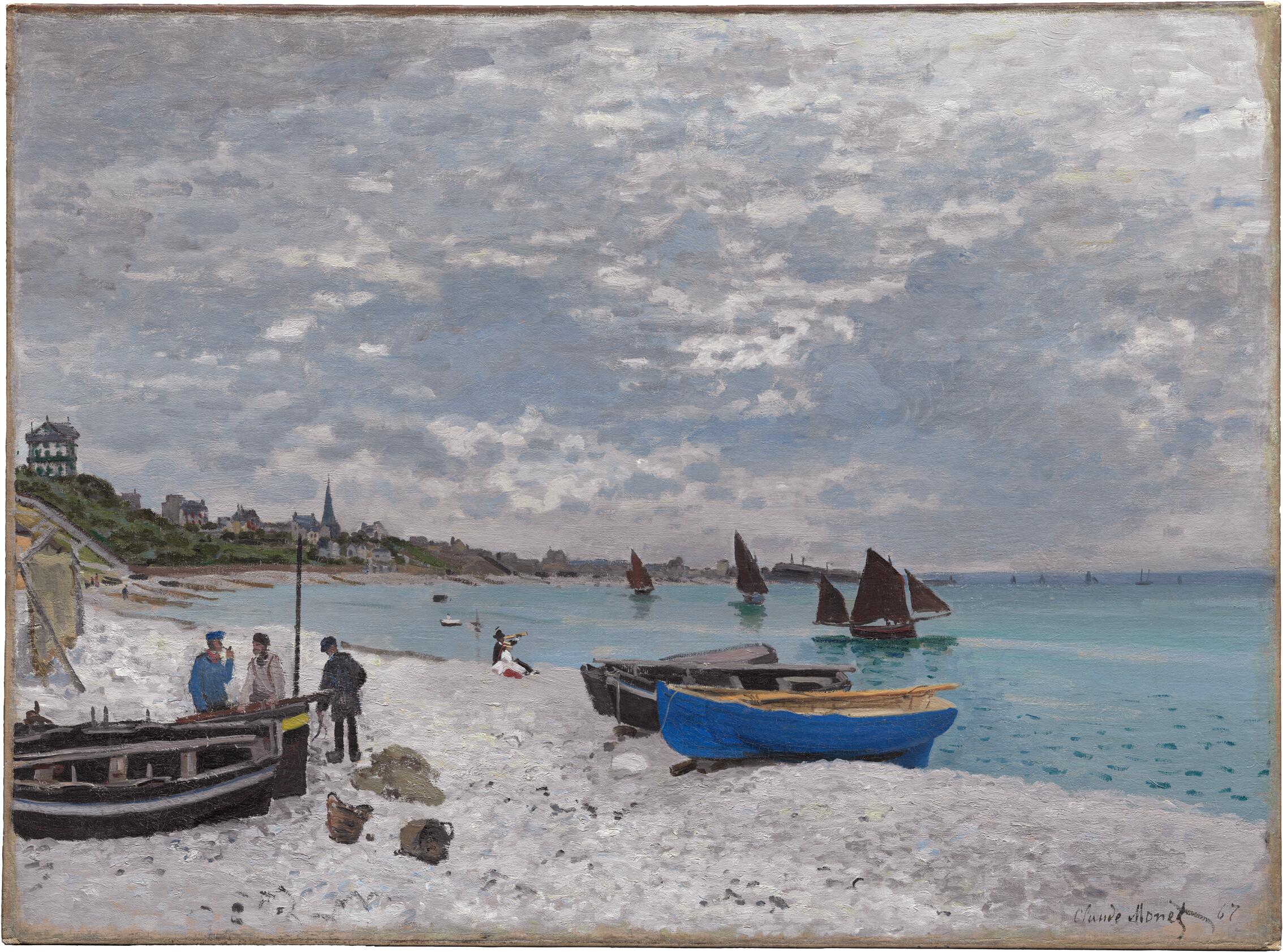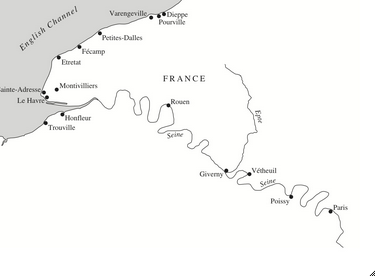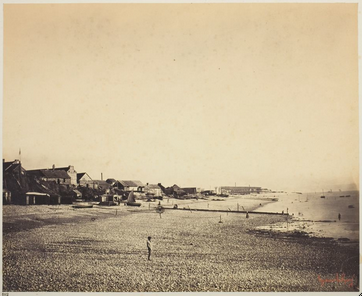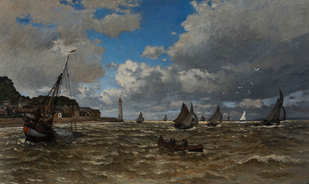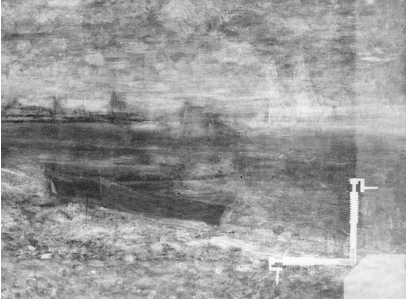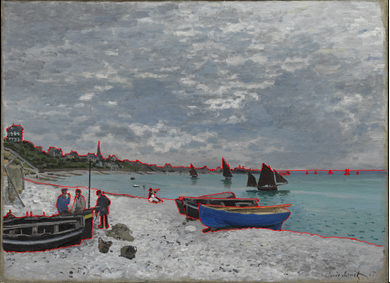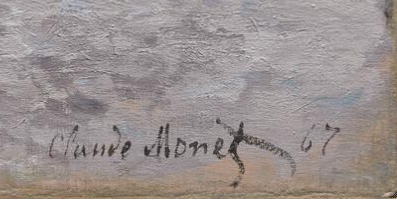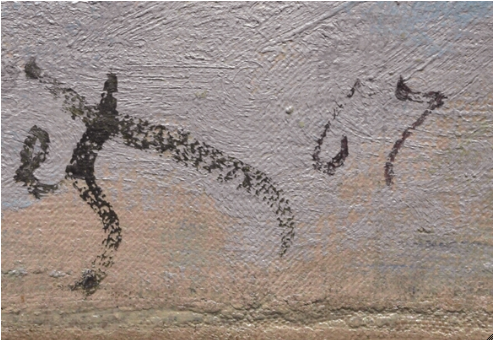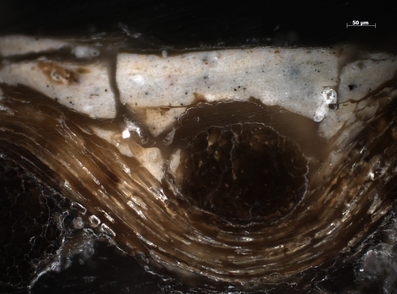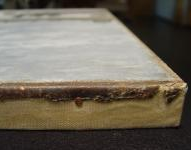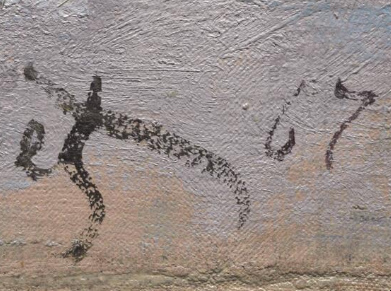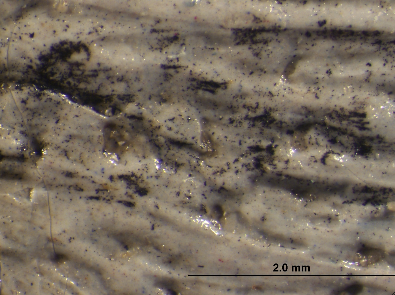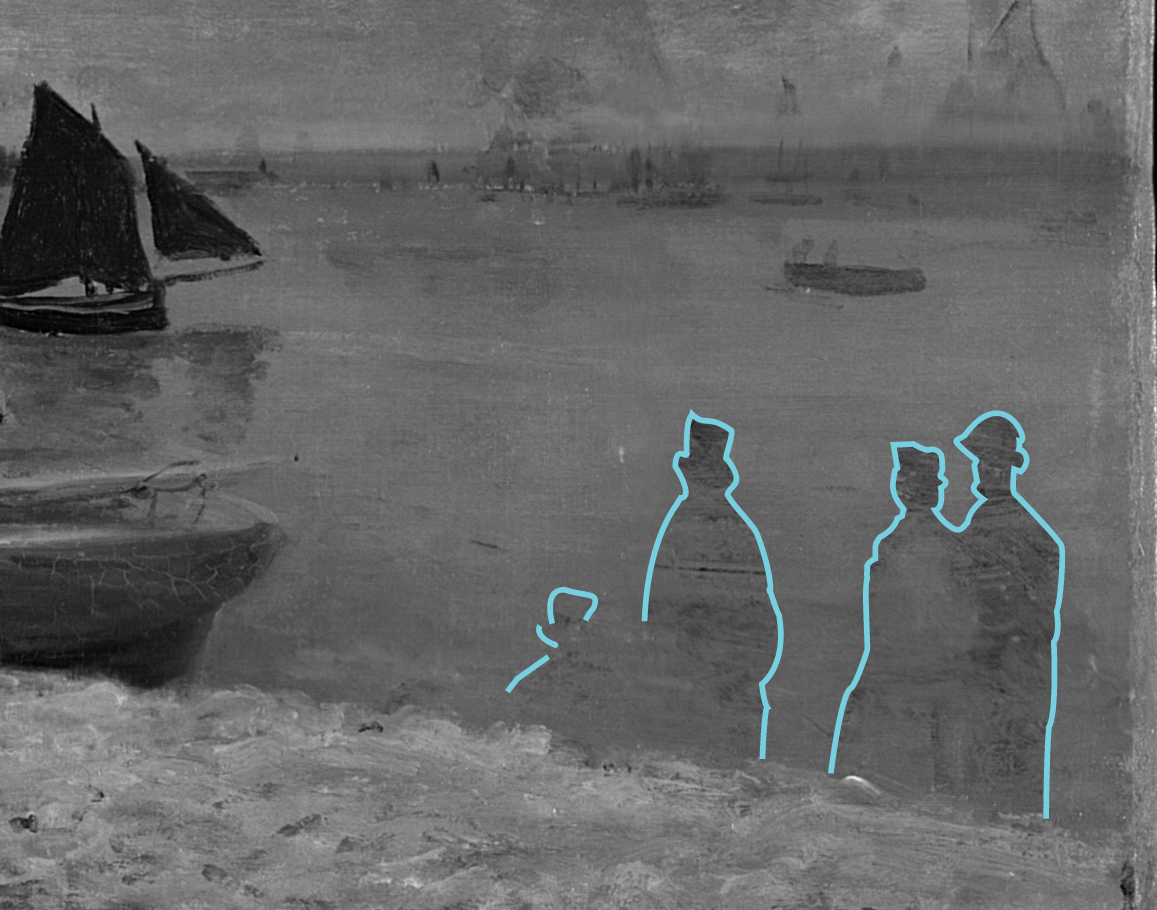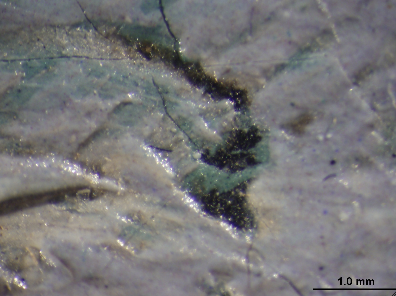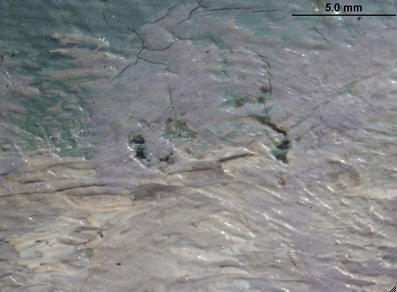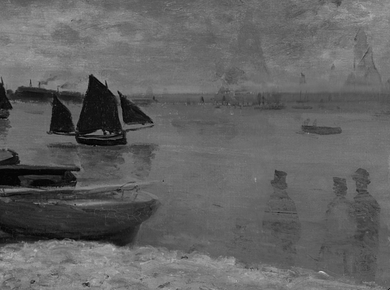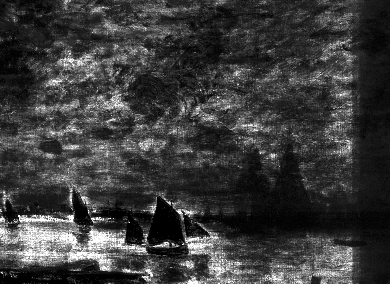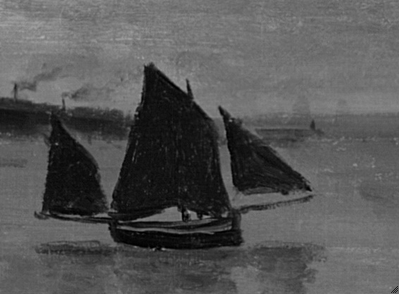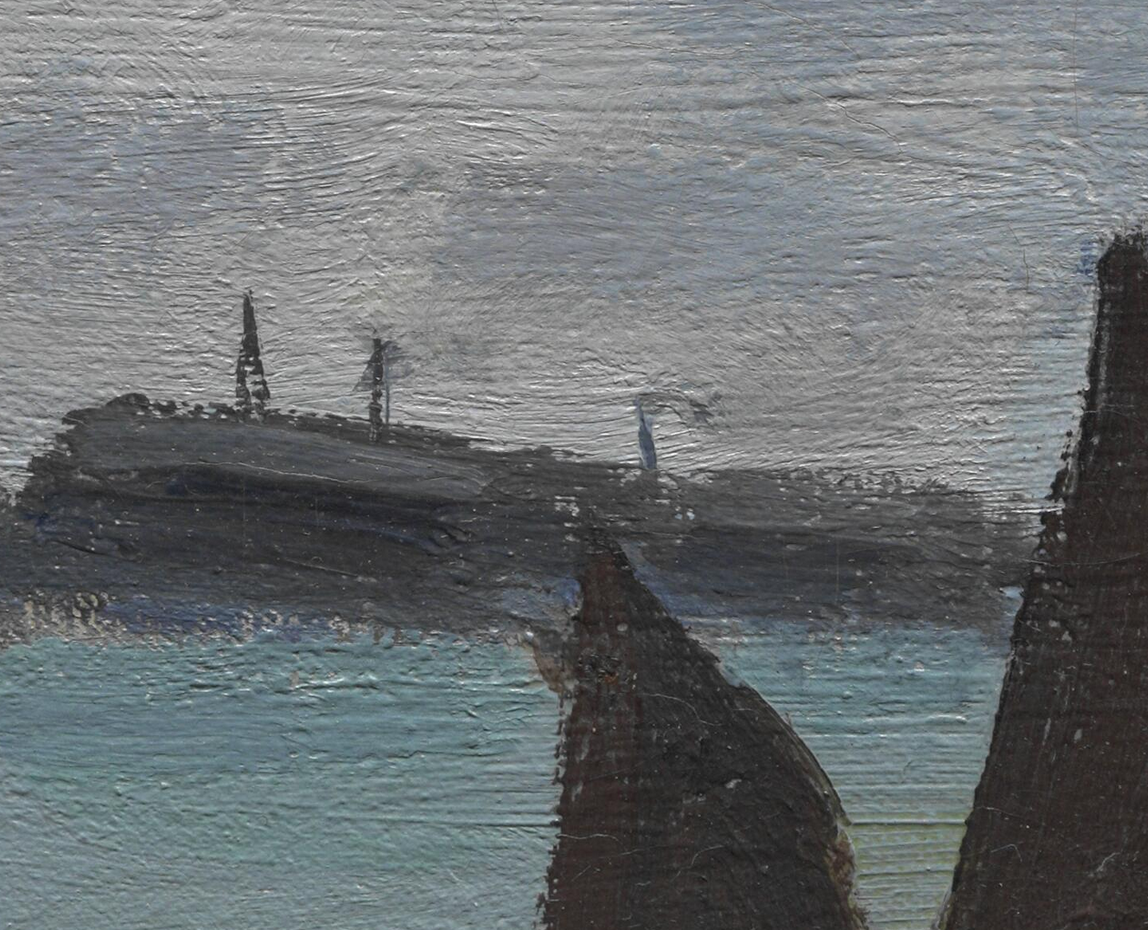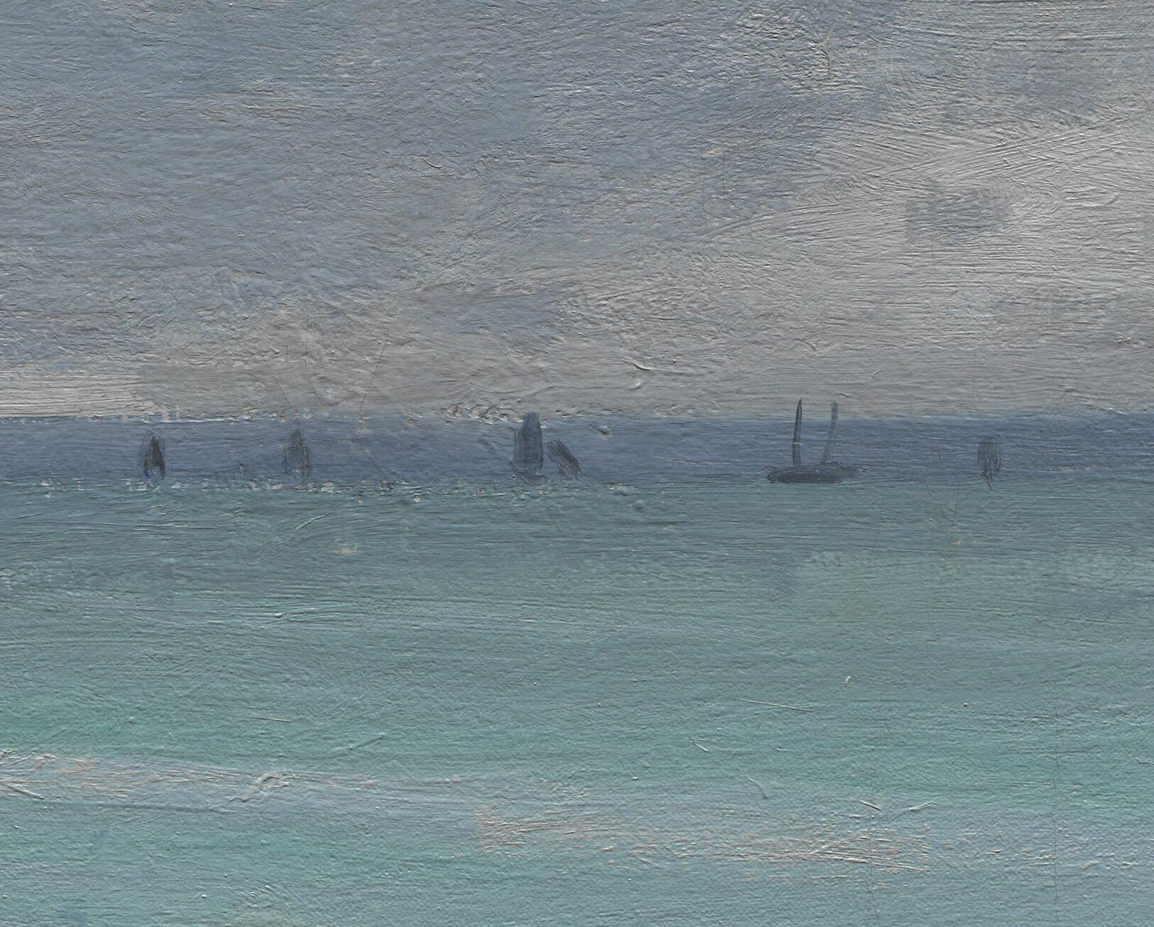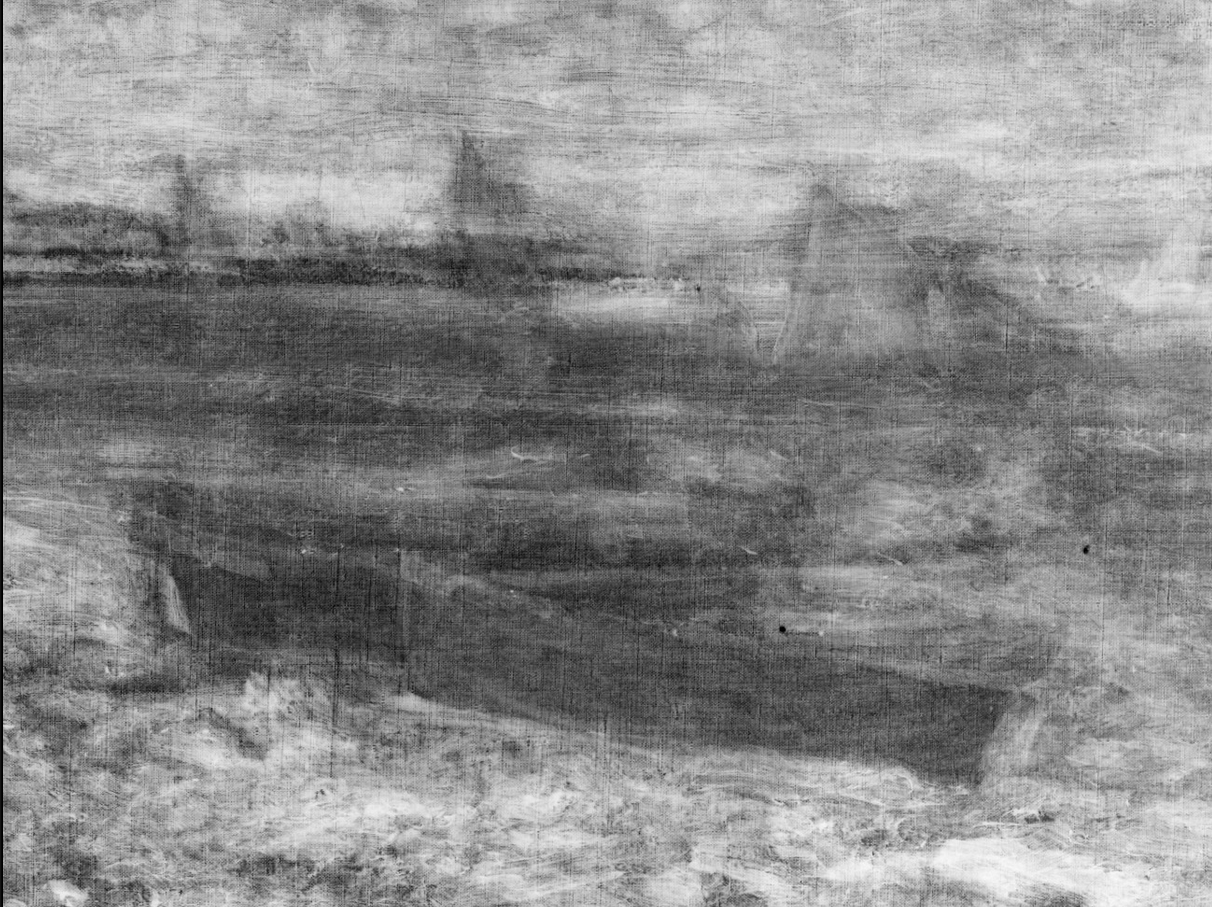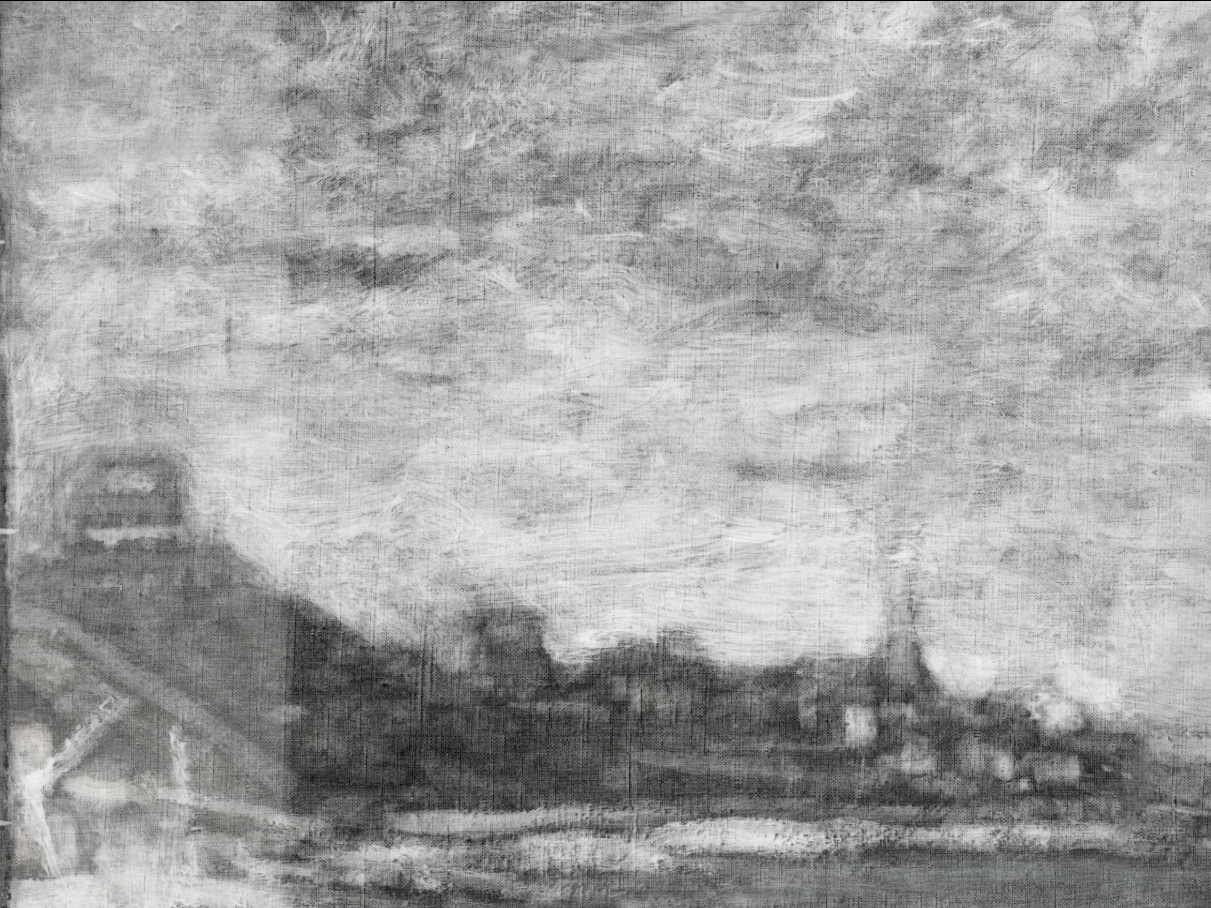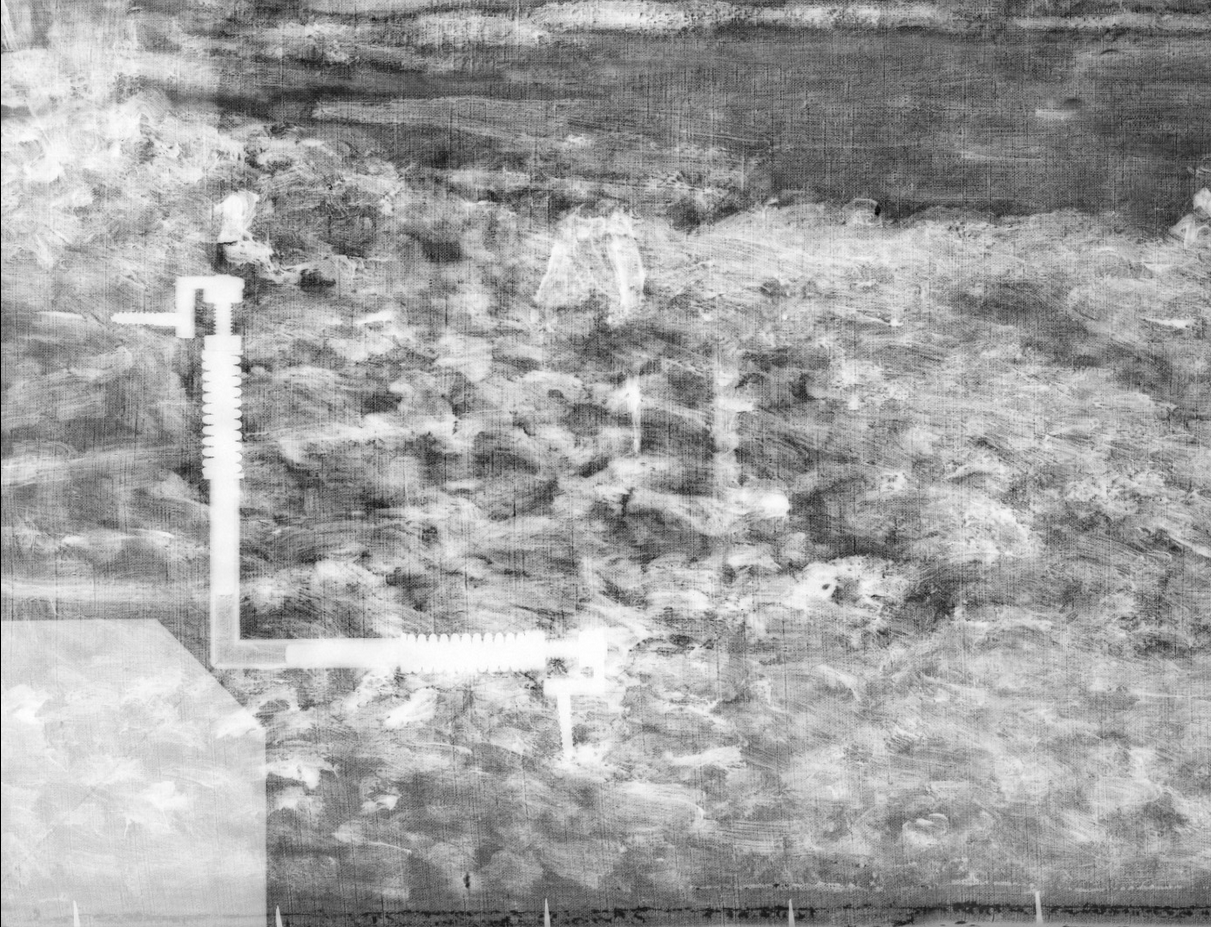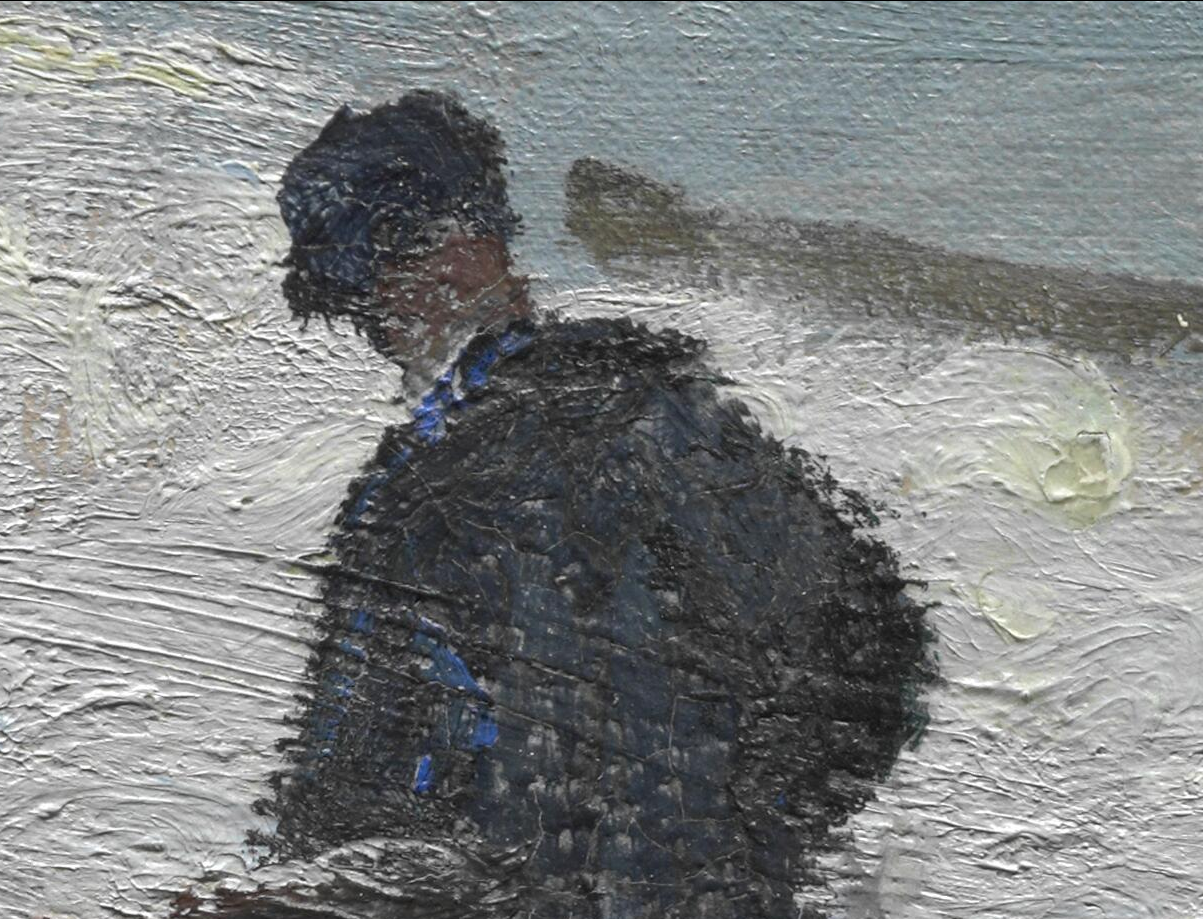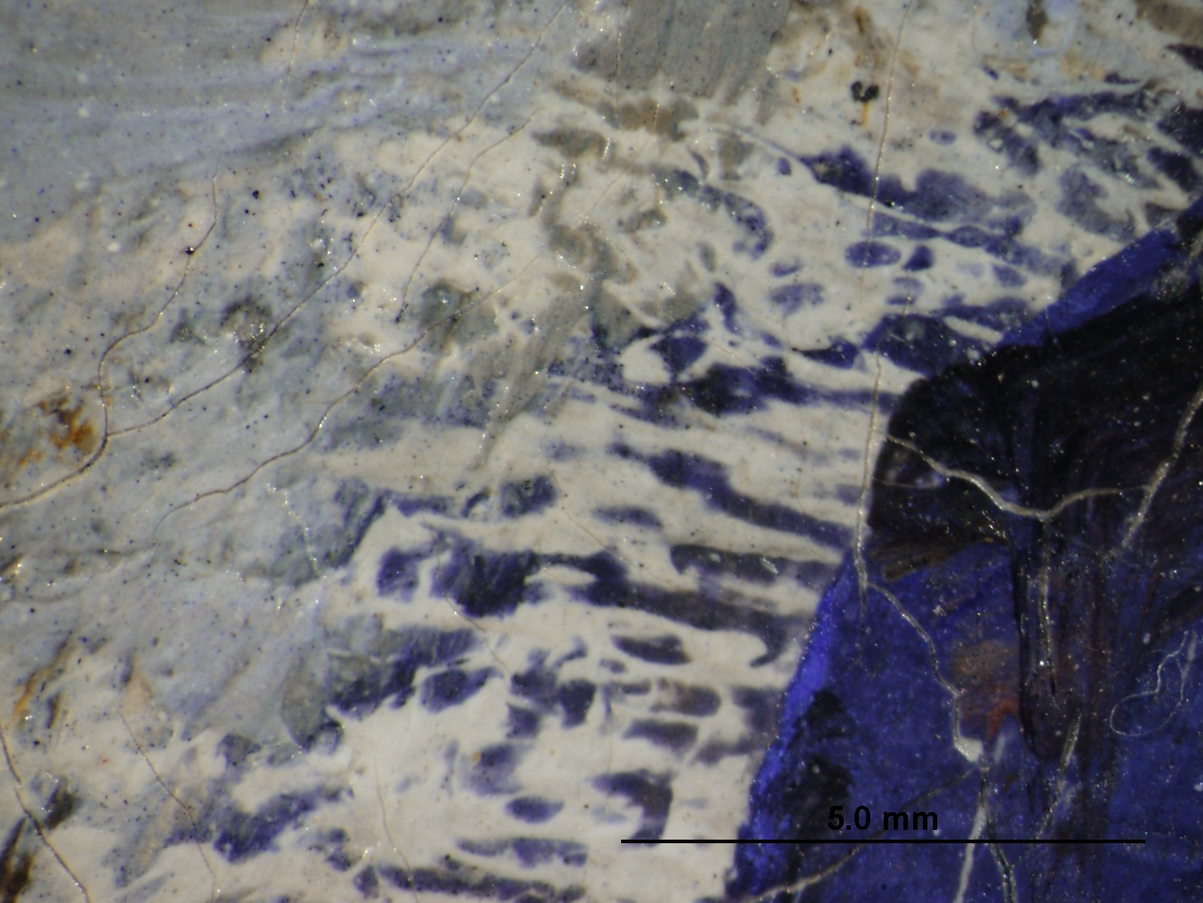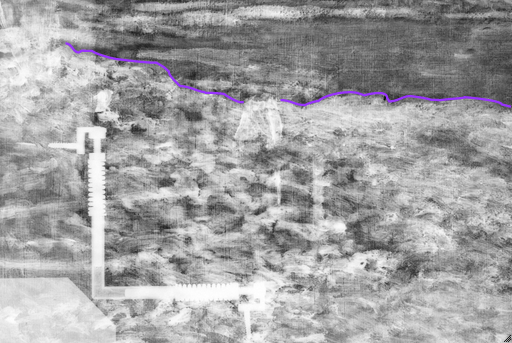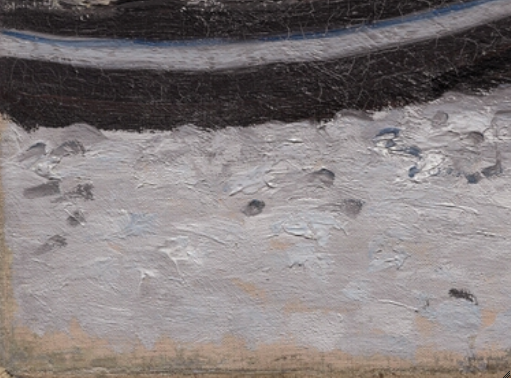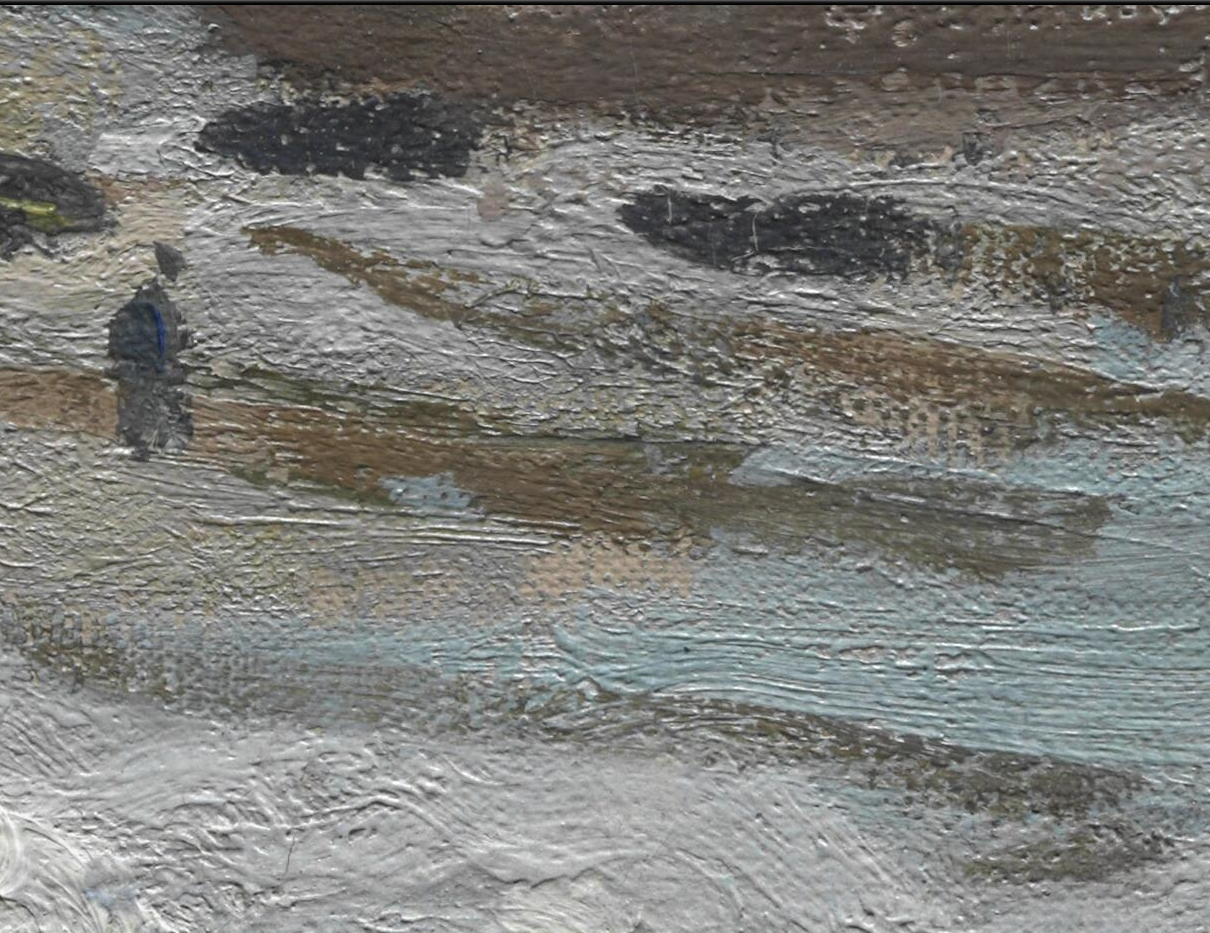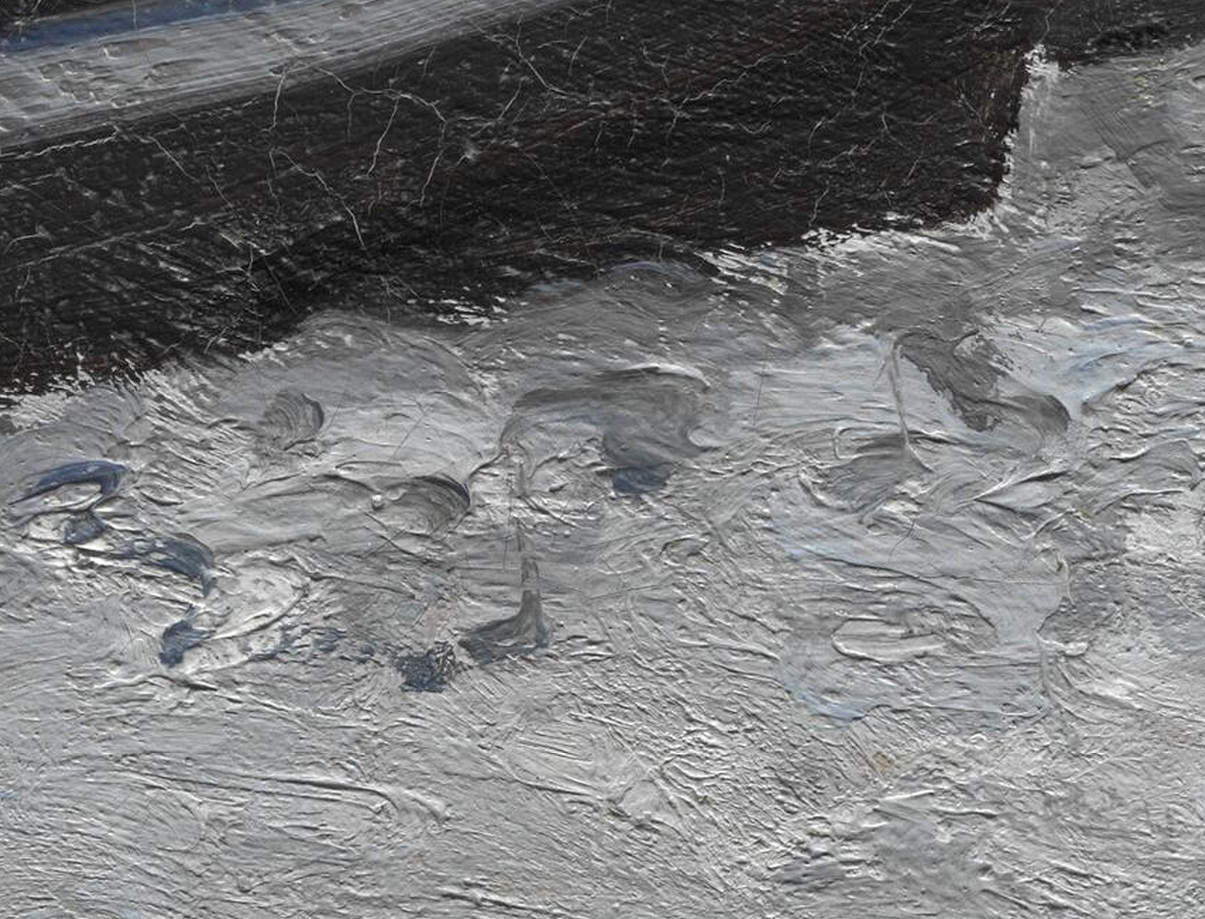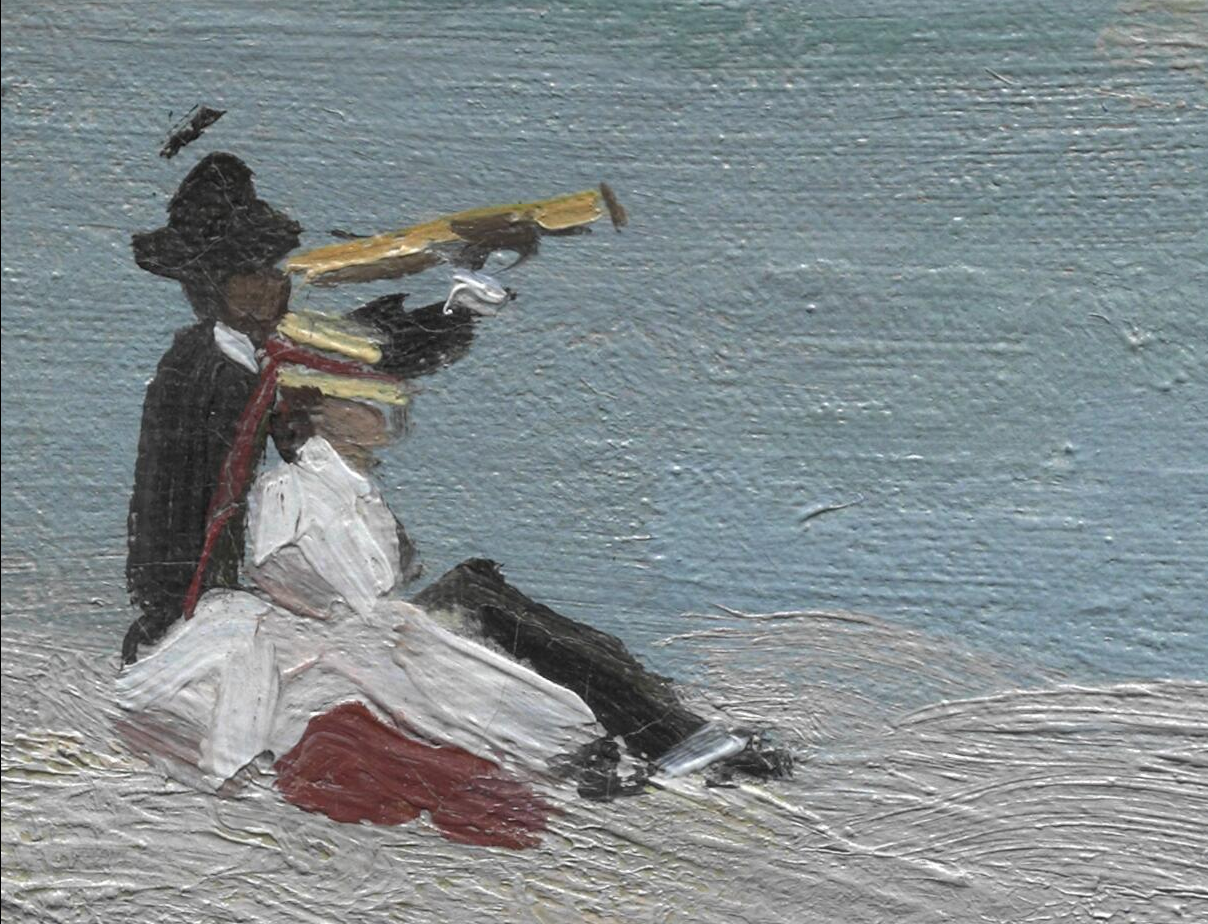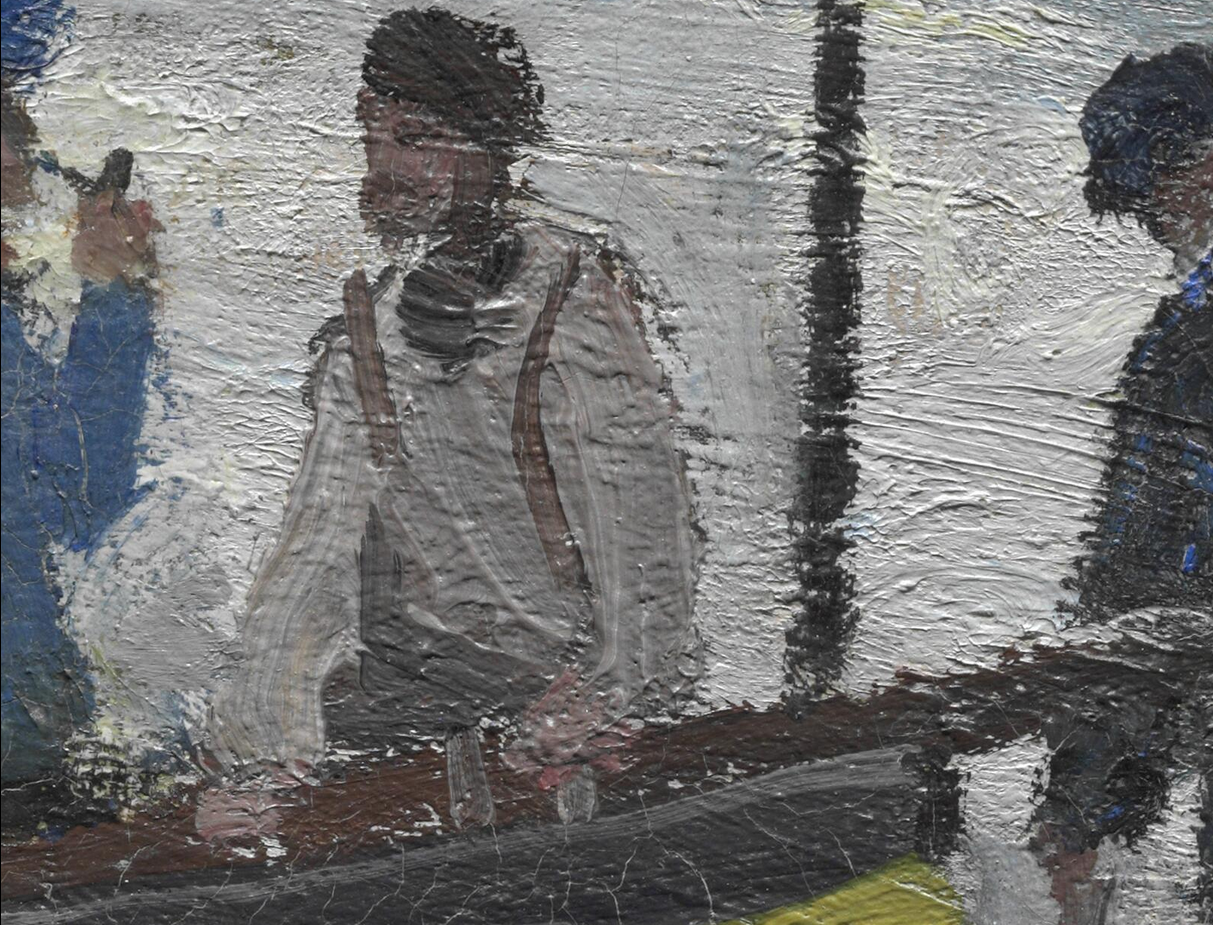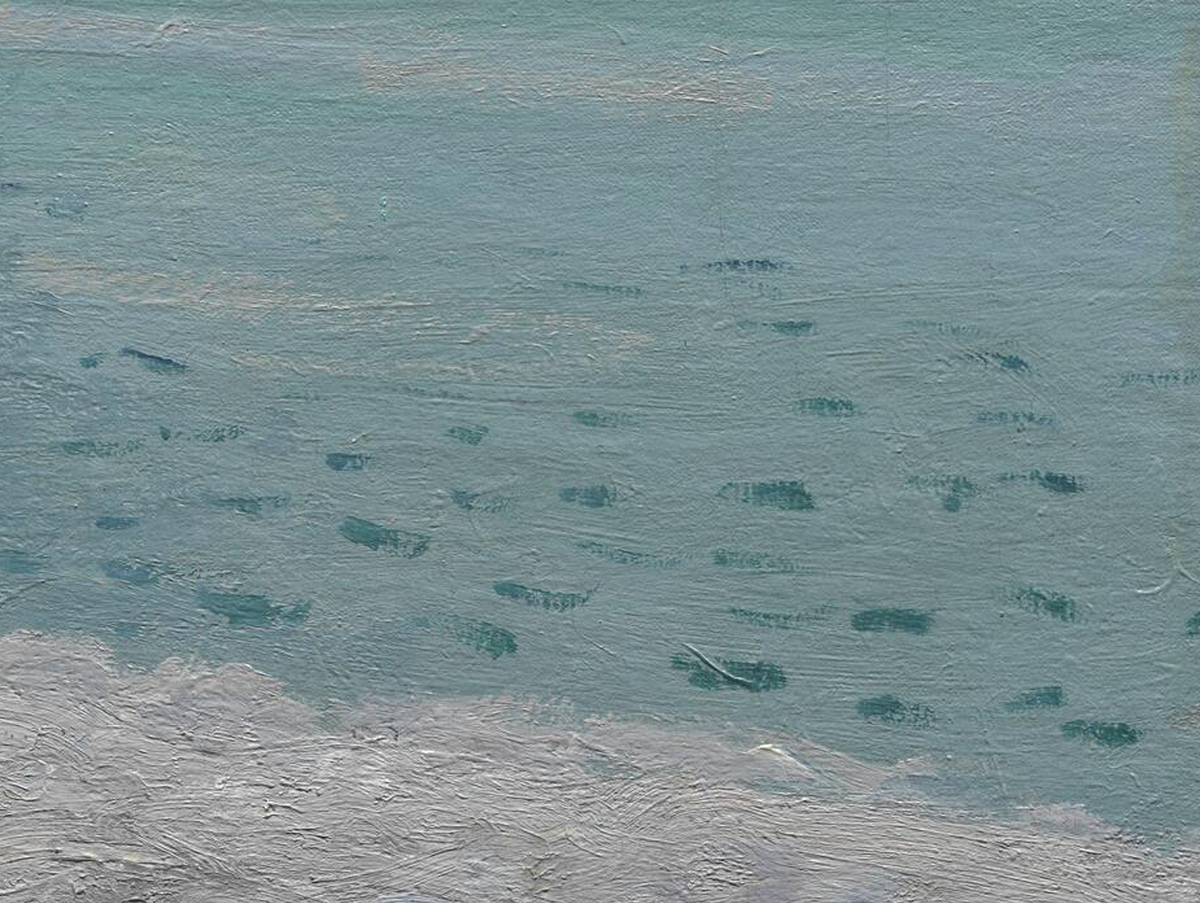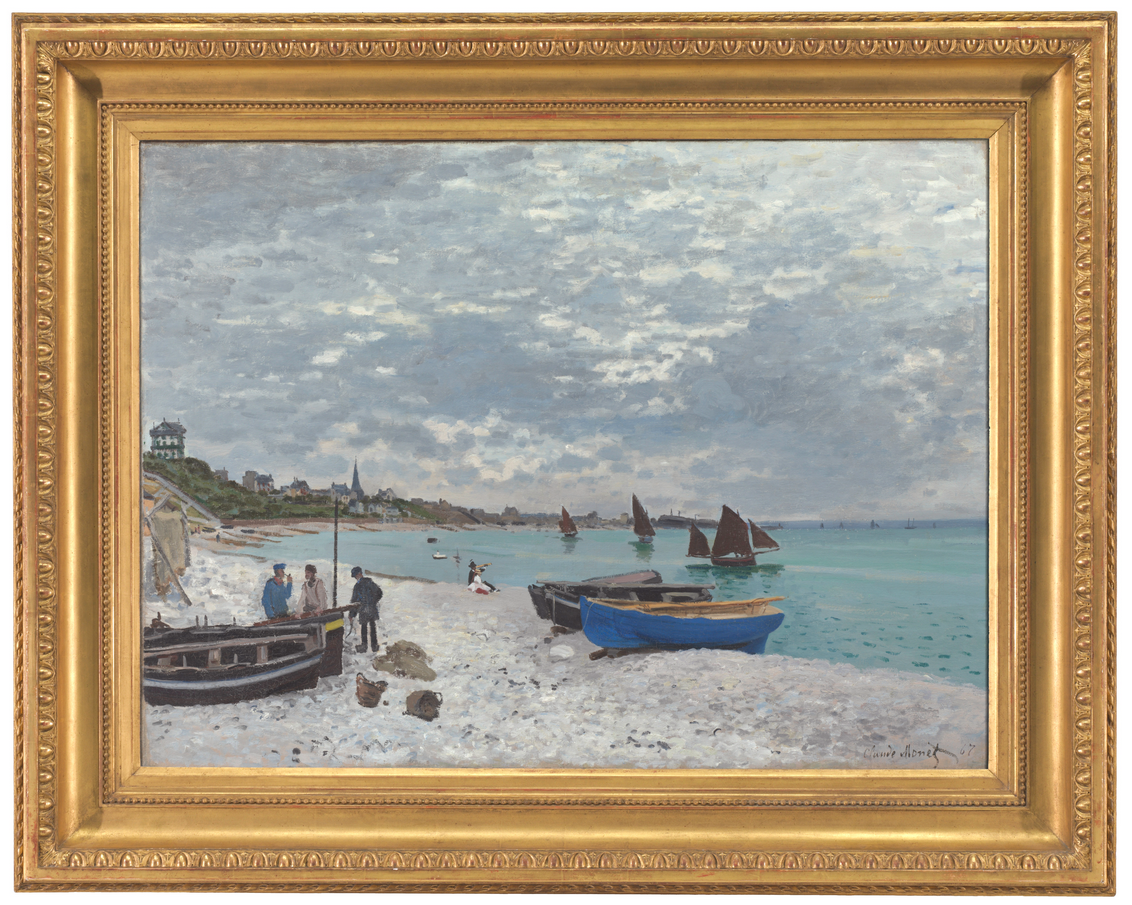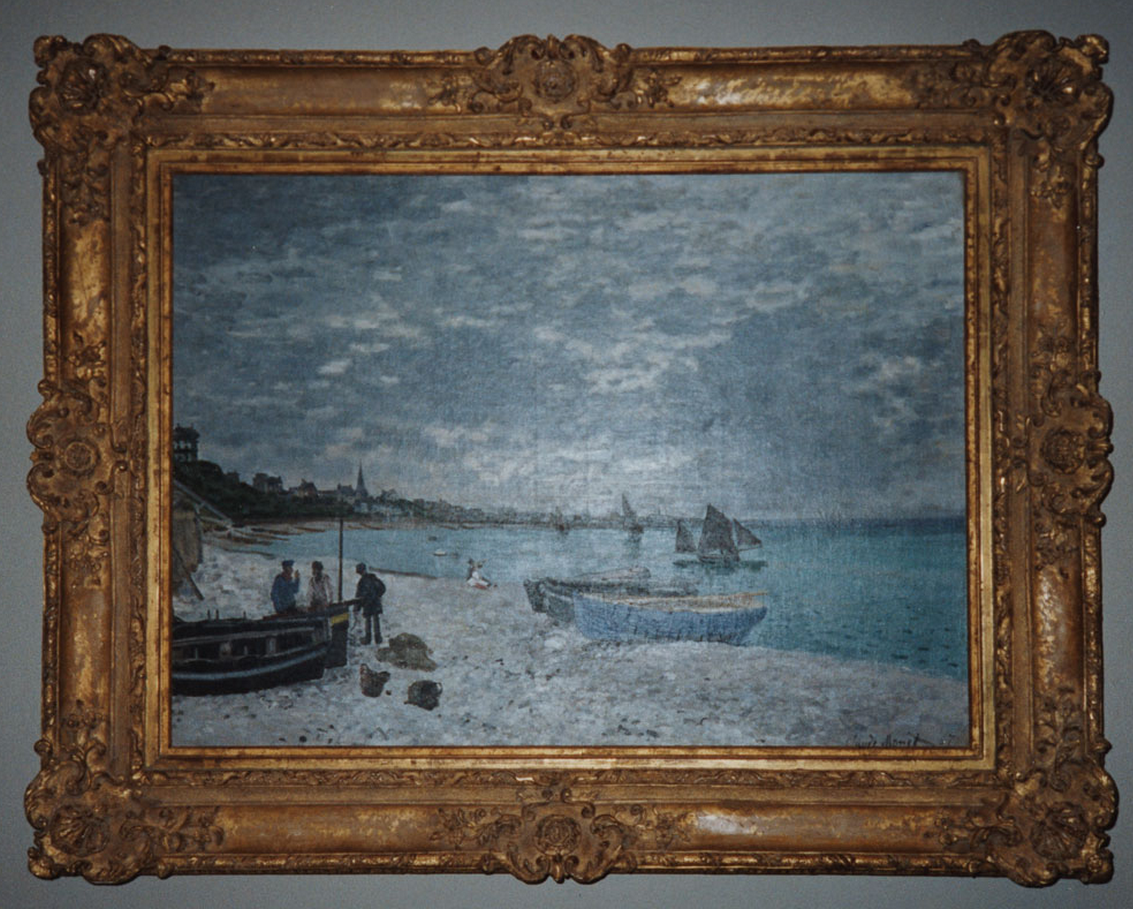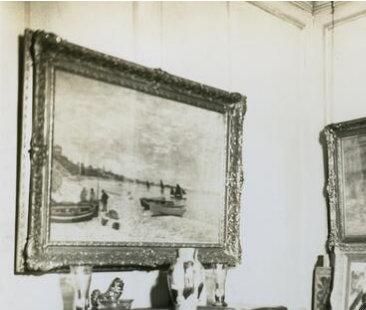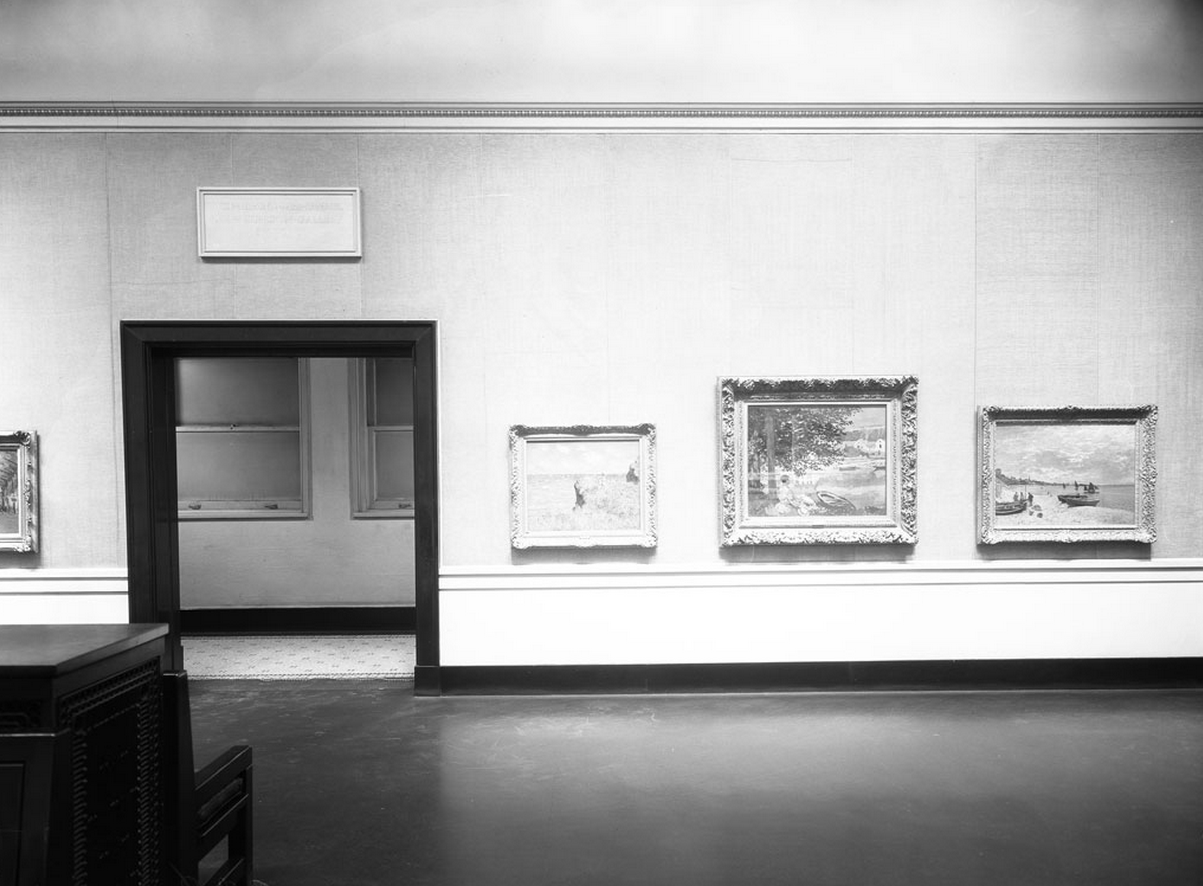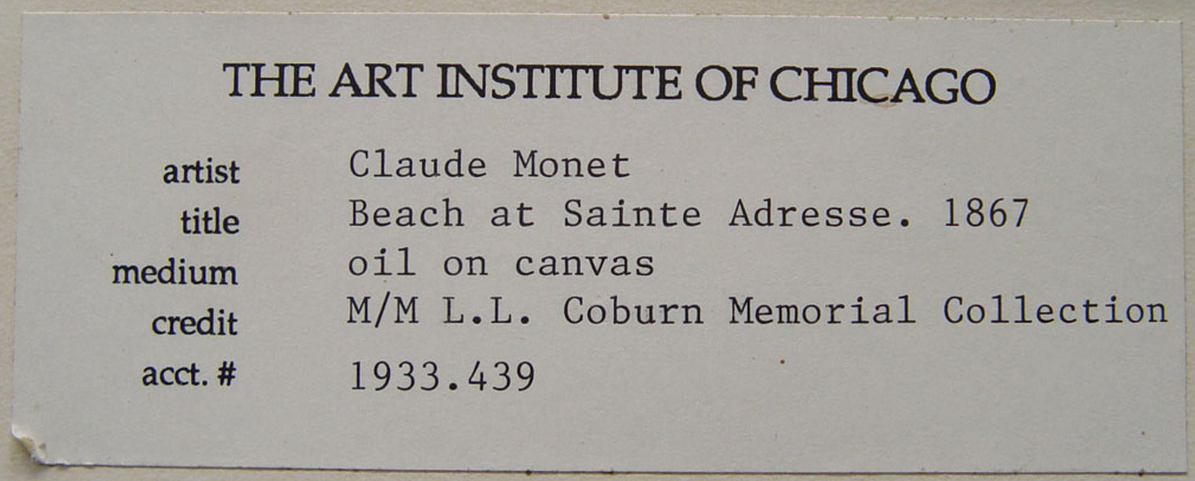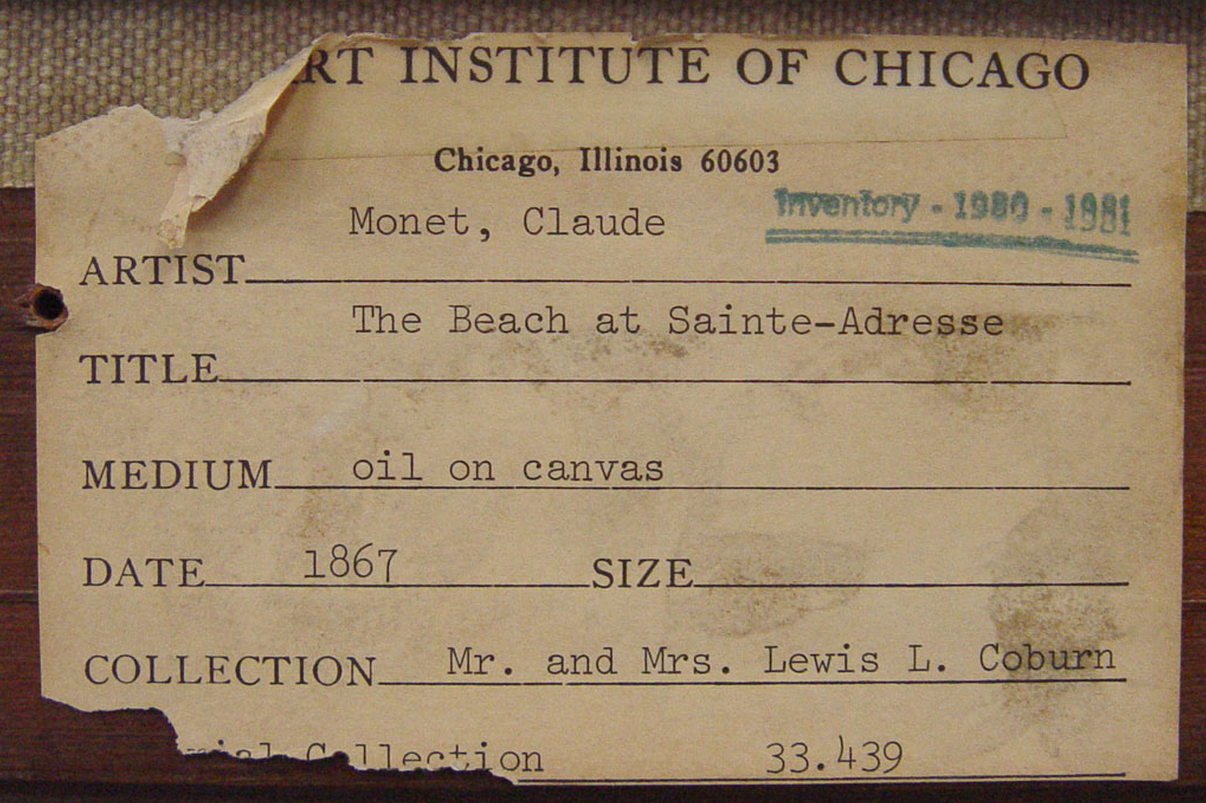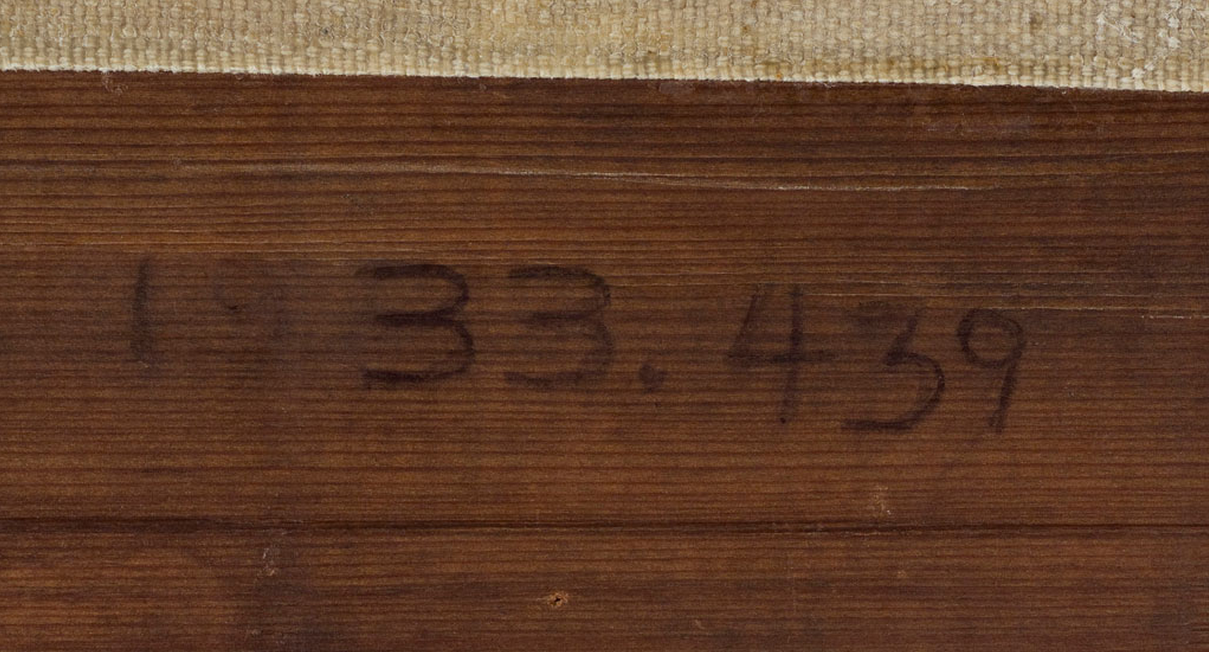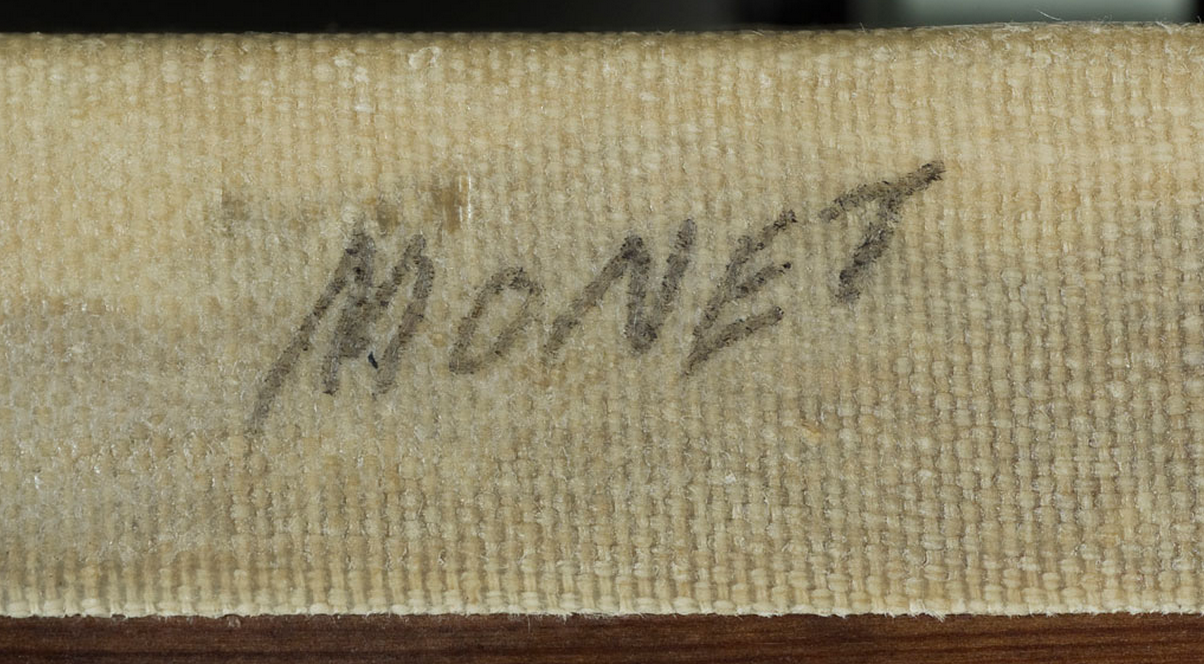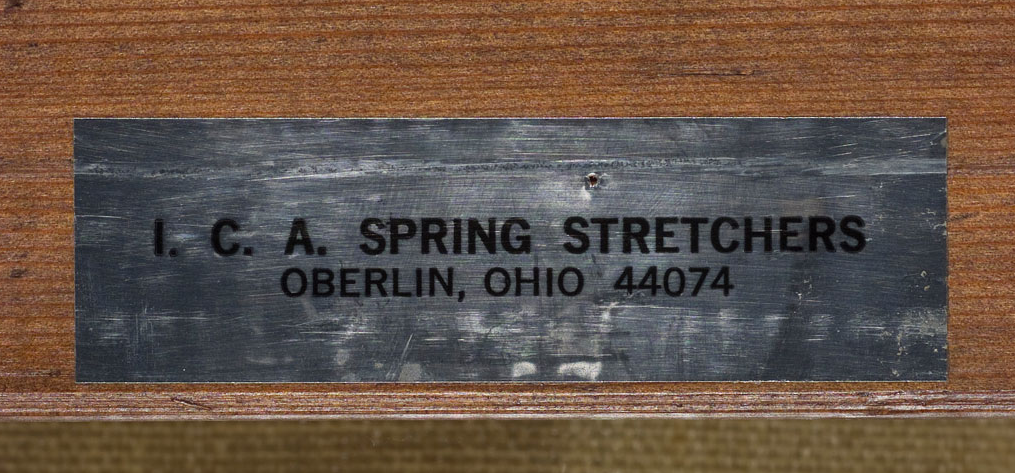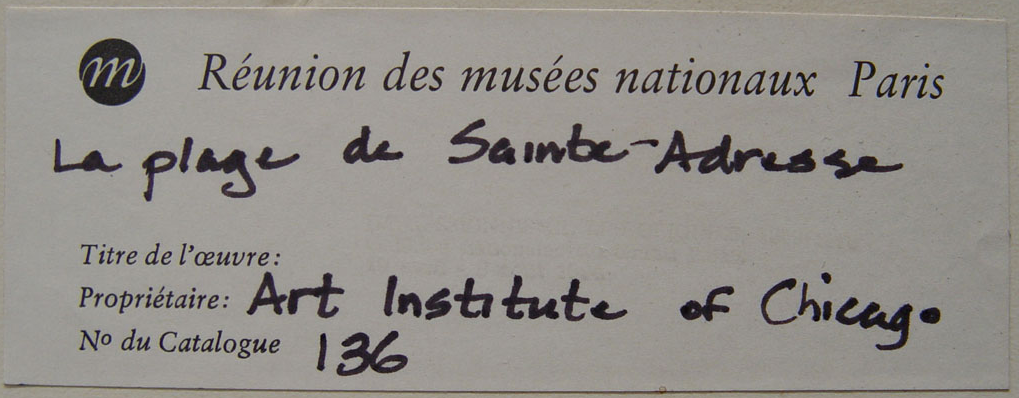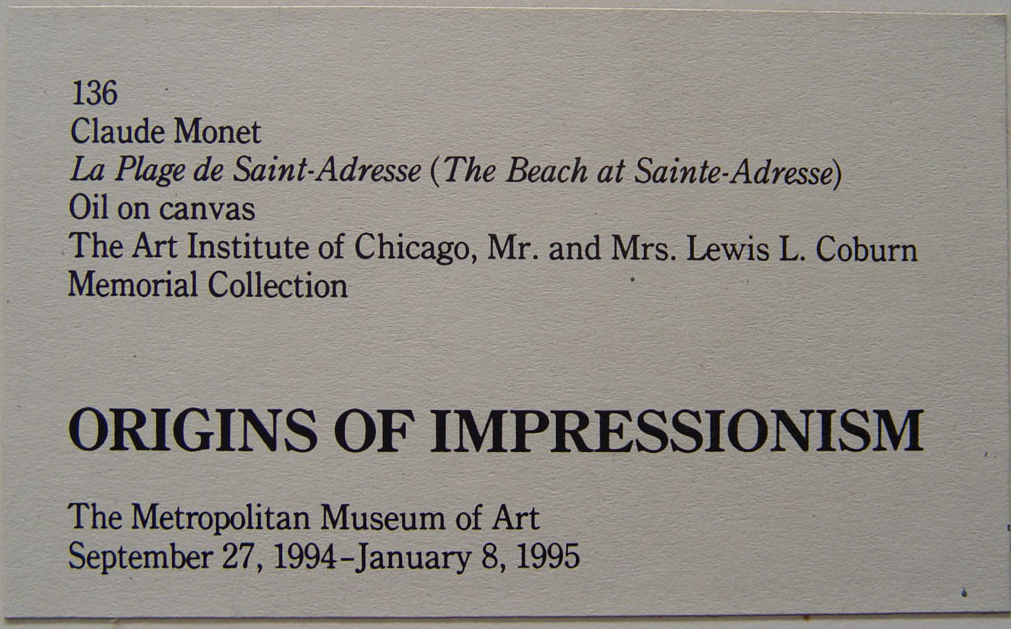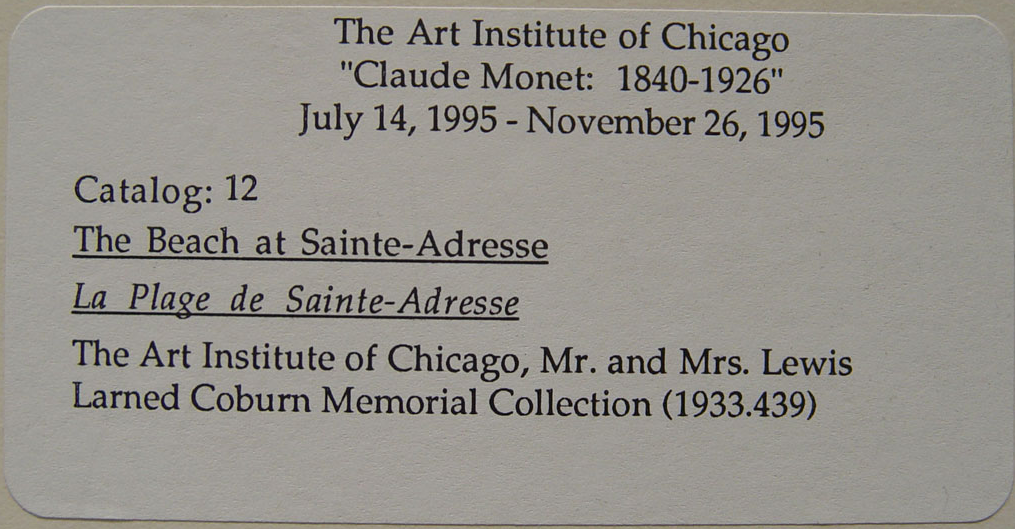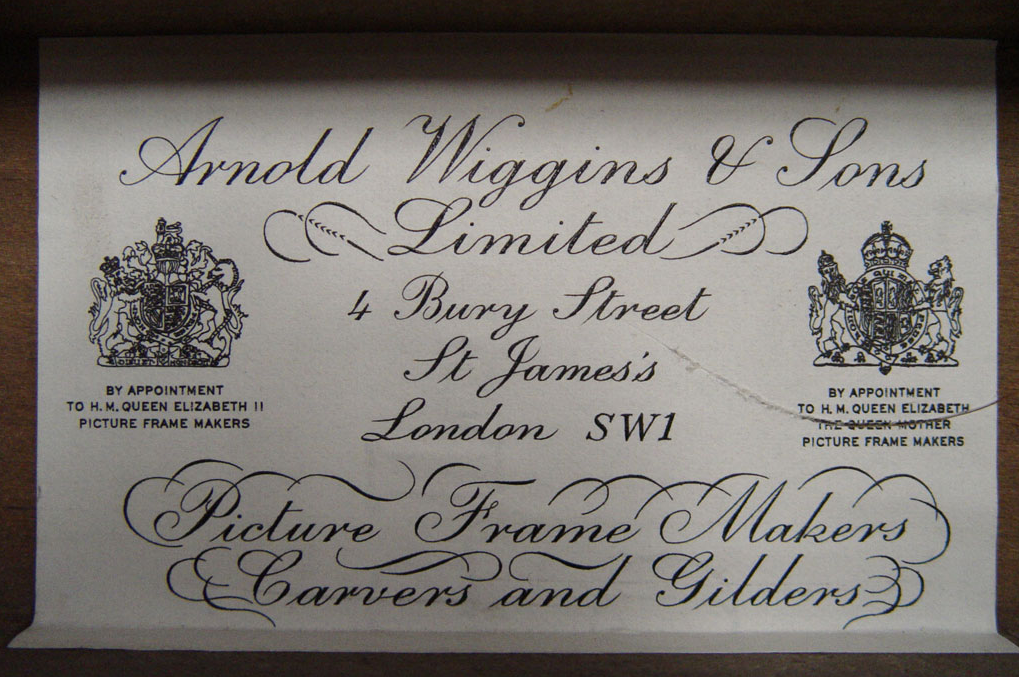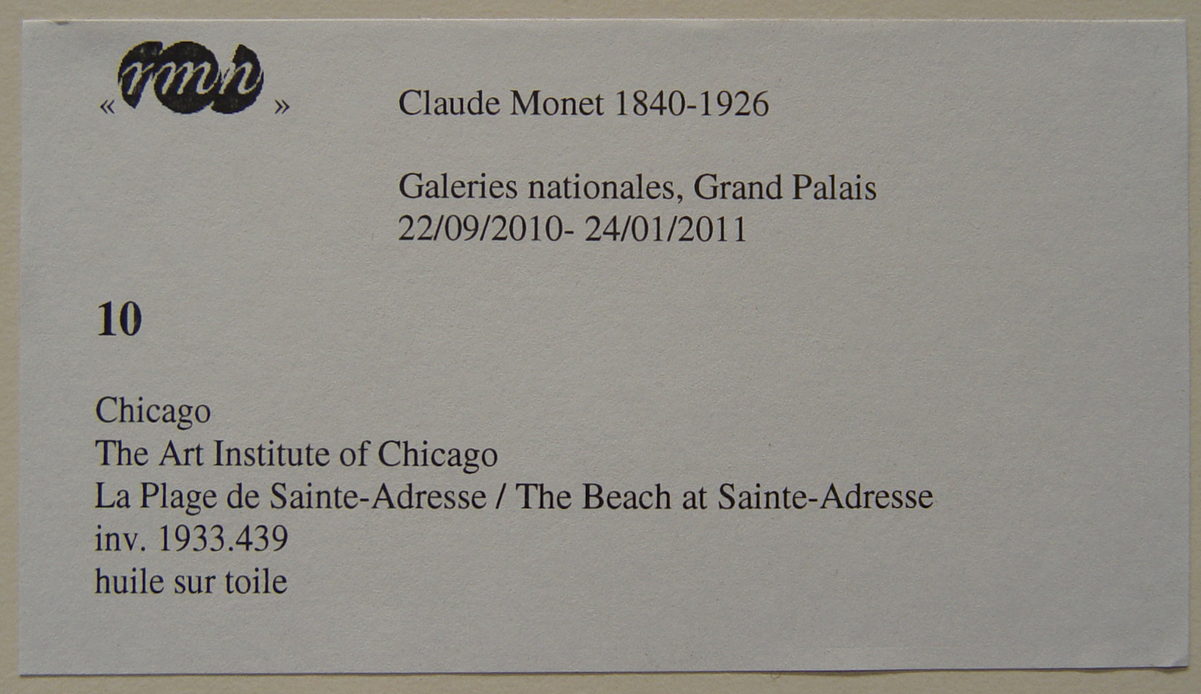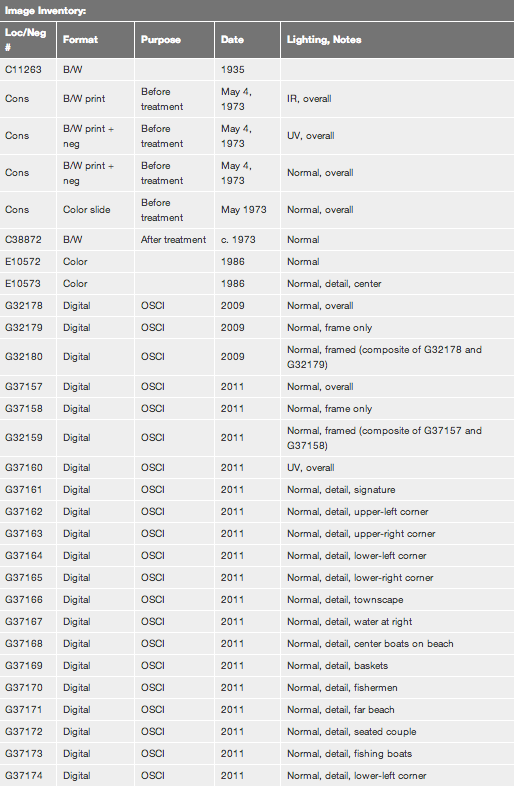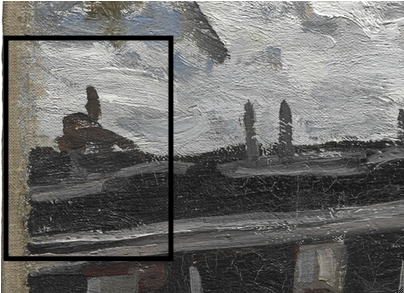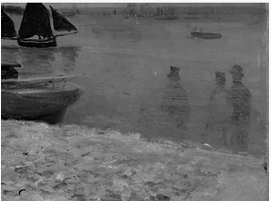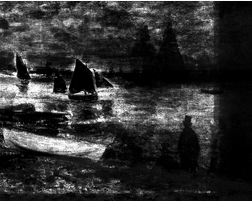Selected References
Possibly “Notice of the Exhibition of the Society of French Artists, New Bond Street,” Times, Apr. 27, 1874. Reprinted in Kate Flint, ed., Impressionists in England: The Critical Reception (Routledge and Kegan Paul, 1984), p. 35.
Possibly Durand-Ruel, London, Eighth Exhibition of the Society of French Artists, exh. cat. (Durand-Ruel, 1874), p. 11, cat. 142.
Marius Chaumelin, “Actualités: L’exposition des intransigeants,” La gazette des étrangers, Apr. 8, 1876, pp. 1–2. Reprinted in Ruth Berson, ed., The New Painting: Impressionism, 1874–1886, Documentation, vol. 1, Reviews (Fine Arts Museums of San Francisco/University of Washington Press, 1996), p. 67.
Emile Blémont, “Les impressionnistes,” Le rappel, Apr. 9, 1876, pp. 2–3. Reprinted in Ruth Berson, ed., The New Painting: Impressionism, 1874–1886, Documentation, vol. 1, Reviews (Fine Arts Museums of San Francisco/University of Washington Press, 1996), p. 63.
Arthur Baignières, “Exposition de peinture par un groupe d’artistes, rue Le Peletier, II,” L’écho universel, Apr. 13, 1876, p. 3. Reprinted in Ruth Berson, ed., The New Painting: Impressionism, 1874–1886, Documentation, vol. 1, Reviews (Fine Arts Museums of San Francisco/University of Washington Press, 1996), p. 55.
Pierre Dax, “Chronique,” L’artiste, May 1, 1876, p. 348. Reprinted in Ruth Berson, ed., The New Painting: Impressionism, 1874–1886, Documentation, vol. 1, Reviews (Fine Arts Museums of San Francisco/University of Washington Press, 1996), p. 70.
Catalogue de la 2e exposition de peinture, exh. cat. (Alcan-Lévy, 1876), p. 15, cat. 151.
Galerie Georges Petit, Claude Monet; A. Rodin, exh. cat. (Imp. de l’Art, 1889), p. 27, cat. 5. Reprinted in Theodore Reff, ed., Miscellaneous Group Exhibitions, Modern Art in Paris 34 (Garland, 1981), n.pag.
Gustave Geffroy, “Claude Monet,” L’art et les artistes 2, 11 (Nov. 1920), p. 64 (ill.).
Gustave Geffroy, Claude Monet: Sa vie, son temps, son oeuvre (G. Crès, 1922), pp. opp. 40 (ill.), 59, 62, 71, 118, 262.
Camille Mauclair, Claude Monet (F. Rieder, 1924), p. 36, pl. 6. Translated by J. Lewis May as Claude Monet (Dodd, Mead, 1924), p. 42, pl. 6.
Xenia Lathom, Claude Monet (Philip Allan, 1931), p. 47, pl. 6.
Eleanor Jewett, “Noted Private Art Collection on Exhibition,” Chicago Daily Tribune, Apr. 6, 1932, p. 19 (ill.).
“Masterpieces of the French Impressionists from the Collection of Mrs. L. L. Coburn Being Exhibited for the First Time at the Art Institute of Chicago,” Fine Arts 19, 1 (June 1932), p. 22 (ill.).
Daniel Catton Rich, “The Bequest of Mrs. L. L. Coburn,” Bulletin of the Art Institute of Chicago 26, 6 (Nov. 1932), pp. 66, 67 (ill.), 68.
“Annie S. Coburn Estate Is Given $888,982 Value,” Chicago Daily Tribune, Nov. 19, 1932, p. 16.
Art Institute of Chicago, Exhibition of the Mrs. L. L. Coburn Collection: Modern Paintings and Watercolors, exh. cat. (Art Institute of Chicago, 1932), pp. 18, no. 19; 47, no. 19.
Daniel Catton Rich, “The Mrs. L. L. Coburn Collection,” in Art Institute of Chicago, Exhibition of the Mrs. L. L. Coburn Collection: Modern Paintings and Watercolors, exh. cat. (Art Institute of Chicago, 1932), p. 7.
Art Institute of Chicago, Bulletin of the Art Institute of Chicago: Report for the Year Nineteen Hundred Thirty-Two 27, 3 (Mar. 1933), p. 24 (ill.).
Art Institute of Chicago, Catalogue of “A Century of Progress”: Exhibition of Paintings and Sculpture; Lent from American Collections, ed. Daniel Catton Rich, 3rd ed., exh. cat. (Art Institute of Chicago, 1933), p. 43, cat. 292.
Roger Brielle, “Le visage de la France vu par nos artistes: III. La Normandie,” L’art et les artistes 28, 143 (Jan. 1934), p. 129 (ill.).
Art Institute of Chicago, Catalogue of “A Century of Progress”: Exhibition of Paintings and Sculpture, 1934, ed. Daniel Catton Rich, exh. cat. (Art Institute of Chicago, 1934), pp. 36–37, cat. 210.
Toledo Museum of Art, Catalogue: French Impressionists and Post-Impressionists, exh. cat. (Toledo Museum of Art, 1934), n.pag., cat. 8 (paintings).
Art Institute of Chicago, A Brief Illustrated Guide to the Collections (Art Institute of Chicago, 1935), p. 28.
William Rockhill Nelson Gallery of Art and Mary Atkins Museum of Fine Arts, “Exhibition of French Impressionist Landscape Paintings,” William Rockhill Nelson Gallery of Art and Atkins Museum of Fine Arts News Flashes 3, 2 (Dec. 1, 1936), p. 2.
William Rockhill Nelson Gallery of Art and Mary Atkins Museum, Exhibition: French Impressionist Landscape Painting, exh. cat. (William Rockhill Nelson Gallery of Art and Mary Atkins Museum, 1936), cover (ill.); p. 6, cat. 23.
Lionello Venturi, Les archives de l’impressionnisme: Lettres de Renoir, Monet, Pissarro, Sisley et autres; Mémoires de Paul Durand-Ruel; Documents, vol. 2 (Durand-Ruel, 1939), p. 257.
Art Institute of Chicago, “List of Exhibitions,” Bulletin of the Art Institute of Chicago 39, 4 (Apr.–May 1945), p. 64.
John Rewald, The History of Impressionism (Museum of Modern Art/Simon & Schuster, 1946), p. 137 (ill.).
Art Institute of Chicago, An Illustrated Guide to the Collections of the Art Institute of Chicago (Art Institute of Chicago, 1948), p. 34.
Oscar Reuterswärd, Monet: En konstnärshistorik (Bonniers, 1948), p. 281.
Art Institute of Chicago, “Notes,” Bulletin of the Art Institute of Chicago 34, 1 (Feb. 1949), p. 15.
Kenneth Clark, Landscape into Art (John Murray, 1949), pp. xiii; 88, pl. 81.
Daniel Catton Rich, “Midwest Art Capital,” Town and Country 105 (Mar. 1951), p. 75 (ill.).
Kunsthaus Zürich, Claude Monet: 1840–1926, with a foreword by Georges Besson and René Wehrli, exh. cat. (Kunsthaus Zürich, 1952), pl. 4; p. 19, cat. 11.
Haags Gemeentemuseum, Claude Monet, with an introduction by George Besson, exh. cat. (Gemeentemuseum, 1952), cat. 9 (ill.).
Meyer Schapiro, Paul Cezanne (Abrams, 1952), pp. 11 (ill.), 12.
Daniel Wildenstein, Claude Monet, exh. cat. (Galerie Beaux-Arts, 1952), pp. 14, cat. 8 (ill.); 59.
Art Institute of Chicago, An Illustrated Guide to the Collections of the Art Institute of Chicago (Art Institute of Chicago, 1956), p. 34.
Art Institute of Chicago, “Homage to Claude Monet,” Art Institute of Chicago Quarterly 51, 2 (Apr. 1, 1957), pp. 22 (ill.), 24.
Art Institute of Chicago, “Chronology,” Art Institute of Chicago Quarterly 51, 2 (Apr. 1, 1957), p. 28.
Art Institute of Chicago, “Catalogue,” Art Institute of Chicago Quarterly 51, 2 (Apr. 1, 1957), p. 33
Art Institute of Chicago, “Exhibitions,” Art Institute of Chicago Quarterly 51, 2 (Apr. 1, 1957), p. 36.
Claude Monet: A Loan Exhibition, exh. cat. (Minneapolis Society of the Fine Arts, 1957), p. 45, cat. 4 (ill.).
William C. Seitz, “Claude Monet’s View of Nature,” in Claude Monet: A Loan Exhibition, exh. cat. (Minneapolis Society of the Fine Arts, 1957), pp. 16, 21, 24.
Denis Rouart, Claude Monet, trans. James Emmons (Skira, 1958), p. 38 (ill.).
William C. Seitz, Claude Monet (Abrams, 1960), pp. 74, 75 (ill.).
Arthur Millier, “Summer Relief: ‘Painters by the Sea,’” Los Angeles Times, Aug. 27, 1961, p. N18 (ill.).
Art Institute of Chicago, Paintings in the Art Institute of Chicago: A Catalogue of the Picture Collection (Art Institute of Chicago, 1961), pp. 278 (ill.), 318.
Frederick A. Sweet, “Great Chicago Collectors,” Apollo 84, 55 (Sept. 1966), pp. 201, fig. 32; 202–03.
Joel Isaacson, “The Early Paintings of Claude Monet” (Ph.D. diss., University of California, Berkeley, 1967), pp. xii, 183–84, 185.
Edward Barry, “The Institute That Art Built,” Chicago Tribune, Mar. 2, 1969, p. 84.
Charles C. Cunningham and Satoshi Takahashi, Shikago Bijutsukan [Art Institute of Chicago], Museums of the World 32 (Kodansha, 1970), p. 55, cat. 41 (ill.); 160–61.
John Maxon, The Art Institute of Chicago (Abrams, 1970), pp. 80 (ill.), 81.
Anthea Callen, “Jean-Baptiste Faure, 1830–1914: A Study of a Patron and Collector of the Impressionists and Their Contemporaries with a Catalogue of His Collection” (M.A. thesis, University of Leicester, 1971), pp. 28; 325–26, cat. 437.
Gerald Needham, “The Paintings of Claude Monet, 1859–1878” (Ph.D. diss., Institute of Fine Arts, New York University, 1971), pp. 88–89; 154–57; fig. 42.
Denis Rouart, “Apparences et reflets,” in Denis Rouart and Jean-Dominique Rey, Monet, nymphéas, ou Les miroirs du temps, with a cat. rais. by Robert Maillard (Hazan, 1972), p. 40.
Kermit Swiler Champa, Studies in Early Impressionism (Yale University Press, 1973), pp. 19; 20, fig. 26.
Daniel Wildenstein, Claude Monet: Biographie et catalogue raisonné, vol. 1, Peintures, 1840–1881 (Bibliothèque des Arts, 1974), pp. 38; 162; 163, cat. 92 (ill.).
M. Therese Southgate, “About the Cover,” JAMA: The Journal of the American Medical Association 232, 4 (Apr. 28, 1975), cover (ill.); p. 340 (ill.).
M. Therese Southgate, “About the Cover,” JAMA: The Journal of the American Medical Association 233, 3 (July 21, 1975), p. 259.
Horst Keller, Die Kunst der französischen Impressionisten (Herder, 1975), pp. 54; 128–29, pl. 80; 269.
Mike Samuels and Nancy Samuels, Seeing with the Mind’s Eye: The History, Techniques, and Uses of Visualization (Random House, 1975), p. 70 (ill.).
Grace Seiberling, “The Evolution of an Impressionist,” in Paintings by Monet, ed. Susan Wise, exh. cat. (Art Institute of Chicago, 1975), p. 30.
Susan Wise, ed., Paintings by Monet, exh. cat. (Art Institute of Chicago, 1975), p. 64, cat. 10 (ill.).
Charles C. Cunningham, Susan D. Peters, and Kathleen Zimmerer, Jongkind and the Pre-Impressionists: Painters of the Ecole Saint-Siméon, exh. cat. (Sterling and Francine Clark Art Institute, 1977), pp. 23; 134, cat. 90 (ill.); 135.
Art Institute of Chicago, 100 Masterpieces (Art Institute of Chicago, 1978), pp. 22; 90–91, fig. 48.
Luigina Rossi Bortolatto, L’opera completa di Claude Monet, 1870–1889, Classici dell’arte 63 (Rizzoli, 1972), pp. 89, cat. 19 (ill.); 90.
Roger Terry Dunn, “The Monet-Rodin Exhibition at the Galerie Georges Petit in 1889” (Ph.D. diss., Northwestern University, 1978), pp. 78, 246.
Gaëtan Picon, The Birth of Modern Painting (Skira, 1978), pp. 62–63 (ill.), 118.
J. Patrice Marandel, The Art Institute of Chicago: Favorite Impressionist Paintings (Crown, 1979), pp. 52–53 (ill.).
J. Patrice Marandel, “New Installation of Earlier Paintings,” Bulletin of the Art Institute of Chicago 73, 1 (Jan.–Feb. 1979), p. 15 (ill.).
Brian Petrie, Claude Monet: The First of the Impressionists (Phaidon, 1979), pp. 31–32, pl. 26; 33.
Hélène Adhémar, Anne Distel, and Sylvie Gache, Hommage à Claude Monet (1840–1926), exh. cat. (Réunion des Musées Nationaux, 1980), pp. 80; 82, cat. 16 bis (ill.).
Diane Kelder, The Great Book of French Impressionism (Abbeville, 1980), pp. 182 (ill.), 437.
Musée Toulouse-Lautrec and Art Institute of Chicago, Trésors impressionnistes du Musée de Chicago, exh. cat. (Musée Toulouse-Lautrec, 1980), pp. 31, no. 9 (ill.); 67.
Andrea P. A. Belloli, ed., A Day in the Country: Impressionism and the French Landscape, exh. cat. (Los Angeles County Museum of Art, 1984), p. 364.
Sylvie Gache-Patin, “Private and Public Gardens,” in A Day in the Country: Impressionism and the French Landscape, ed. Andrea P. A. Belloli, exh. cat. (Los Angeles County Museum of Art, 1984), p. 217.
Sylvie Gache-Patin and Scott Schaefer, “Impressionism and the Sea,” in A Day in the Country: Impressionism and the French Landscape, ed. Andrea P. A. Belloli, exh. cat. (Los Angeles County Museum of Art, 1984), p. 276.
Scott Schaefer, “The French Landscape Sensibility,” in A Day in the Country: Impressionism and the French Landscape, ed. Andrea P. A. Belloli, exh. cat. (Los Angeles County Museum of Art, 1984), pp. 58; 62; 66; 69, no. 6 (ill.).
Scott Schaefer, “L’évasion loin de Paris,” in Réunion des Musées Nationaux, L’impressionnisme et le paysage français, exh. cat. (Réunion des Musées Nationaux, 1985), p. 342.
Scott Schaefer, “The Retreat from Paris,” in A Day in the Country: Impressionism and the French Landscape, ed. Andrea P. A. Belloli, exh. cat. (Los Angeles County Museum of Art, 1984), p. 312.
Sylvie Gache-Patin, “Jardins privés et jardins publics,” in Réunion des Musées Nationaux, L’impressionnisme et le paysage français, exh. cat. (Réunion des Musées Nationaux, 1985), p. 222.
Sylvie Gache-Patin and Scott Schaefer, “La mer,” in Réunion des Musées Nationaux, L’impressionnisme et le paysage français, exh. cat. (Réunion des Musées Nationaux, 1985), p. 295.
Scott Schaefer, “Le paysage dans la peinture française au cours des années 1860,” in Réunion des Musées Nationaux, L’impressionnisme et le paysage français, exh. cat. (Réunion des Musées Nationaux, 1985), pp. 46; 48; 54–55, no. 6 (ill.).
Richard Shiff, Cézanne and the End of Impressionism: A Study of the Theory, Technique, and Critical Evaluation of Modern Art (University of Chicago Press, 1984), pp. 108; 110–11, fig. 21; 116.
John House, “Monet and the Genesis of His Series,” in Auckland City Art Gallery, Claude Monet: Painter of Light, exh. cat. (Auckland City Art Gallery/NZI, 1985), pp. 12; 13, fig. 3.
Hollis Clayson, “A Failed Attempt,” in The New Painting: Impressionism, 1874–1886, ed. Charles S. Moffett, exh. cat. (Fine Arts Museums of San Francisco, 1986), p. 147.
Charles S. Moffett, ed., The New Painting: Impressionism, 1874–1886, exh. cat. (Fine Arts Museums of San Francisco, 1986), pp. 162; 163; 180, cat. 31 (ill.).
Richard R. Brettell, French Impressionists (Art Institute of Chicago/Abrams, 1987), pp. 10 (detail), 11, 12 (ill.), 118.
Douglas Skeggs, River of Light: Monet’s Impressions of the Seine (Victor Gollancz, 1987), pp. 37, 39 (ill.).
Robert L. Herbert, Impressionism: Art, Leisure, and Parisian Society (Yale University Press, 1988), pp. 264–65, pl. 267 (detail); 265; 284; 289, pl. 295; 290; 292; 296.
Ministry of Culture; State Hermitage Museum; Pushkin State Museum of Fine Arts; Metropolitan Museum of Art, New York; and Art Institute of Chicago, Ot Delakrua do Matissa: Shedevry frantsuzskoi zhivopisi XIX–nachala XX veka, iz Muzeia Metropoliten v N’iu-Iorke i Khudozhestvennogo Instituta v Chikago [From Delacroix to Matisse: Masterpieces of French Painting of the Nineteenth to the Beginning of the Twentieth Century from the Metropolitan Museum of Art, New York, and the Art Institute of Chicago], trans. from English by Iu. A. Kleiner and A. A. Zhukov, exh. cat. (Avrora, 1988), pp. 76–77, cat. 27 (ill.).
Francesco Arcangeli, Monet (Nuova Alfa, 1989), pp. 29–30; 82, fig. 8.
Michael Howard, Monet (Brompton, 1989), p. 50 (ill.).
Richard Kendall, ed., Monet by Himself: Paintings, Drawings, Pastels, Letters, trans. Bridget Strevens Romer (Macdonald Orbis, 1989), pp. 43 (ill.), 317.
Musée Rodin, Claude Monet; Auguste Rodin: Centenaire de l’exposition de 1889, exh. cat. (Musée Rodin, 1989), pp. 53, 74 (ill.).
Jacques Vilain, “Les débuts (1840–1870),” in Musée Rodin, Claude Monet; Auguste Rodin: Centenaire de l’exposition de 1889, exh. cat. (Musée Rodin, 1989), p. 111.
Alvin Martin and Judi Freeman, “The Distant Cousins in Normandy: Braque, Dufy, and Friesz,” in Judi Freeman, The Fauve Landscape, exh. cat. (Los Angeles County Museum of Art/Abbeville, 1990), p. 226, pl. 237.
Denis Rouart, Monet (Nathan, 1990), p. 23 (ill.).
Karin Sagner-Düchting, Claude Monet, 1840–1926: Ein Fest für die Augen (Benedikt Taschen, 1990), pp. 36–37 (ill.), 38. Translated by Karen Williams as Claude Monet, 1840–1926: A Feast for the Eyes (Taschen, 2004), pp. 36–37 (ill.), 38.
John Russell Taylor, Impressionist Dreams: The Artists and the World They Painted (Barrie & Jenkins, 1990), p. 59 (ill.).
Stanley David Gedzelman, “Weather Forecasts in Art,” Leonardo 24, 4 (1991), pp. 446; 447, fig. 6.
Stanley David Gedzelman, “The Sky in Art,” Weatherwise 44, 6 (Dec. 1991/Jan. 1992), pp. 10 (ill), 11, 12.
Norma Broude, Impressionism: A Feminist Reading (Rizzoli, 1991), pp. 24; 93, pl. 13.
Charles S. Moffett, “Sainte-Adresse,” in National Gallery of Art, Art for the Nation: Gifts in Honor of the 50th Anniversary of the National Gallery of Art, exh. cat. (National Gallery of Art, Washington, D.C., 1991), p. 154.
Hermann Bauer, Hubert Burda, and Christa Maar, eds., “Impressionismus: Spurensuche für die Jahrhundertwende,” special issue, Pan 1 (1992), p. 4 (ill.).
Sophie Fourny-Dargère, Monet, Profils de l’art (Chêne, 1992), pp. 148, fig. 13; 156.
Sylvie Patin, Monet: “Un oeil . . . mais, bon Dieu, quel oeil!” (Gallimard/Réunion des Musées Nationaux, 1991), pp. 12–13 (detail). Translated by Anthony Roberts as Monet: The Ultimate Impressionist (Abrams, 1993), pp. 12–13 (detail).
Daniel Wildenstein, Claude Monet: Catalogue raisonné, vol. 5, Supplément aux peintures: Dessins; Pastels; Index (Wildenstein Institute, 1991), p. 23, cat. 92.
Virginia Spate, Claude Monet: Life and Work (Rizzoli, 1992), pp. 46–47, ill. 43, 48, 115, 117, 154.
Art Institute of Chicago, Treasures of 19th- and 20th-Century Painting: The Art Institute of Chicago, with an introduction by James N. Wood (Art Institute of Chicago/Abbeville, 1993), p. 50 (ill.).
Robert L. Herbert, Monet on the Normandy Coast: Tourism and Painting, 1867–1886 (Yale University Press, 1994), pp. ii (detail); 10; 11; 12, fig. 13.
Henri Lallemand, Monet: Impressions of Light (Todtri, 1994), pp. 23, 39 (ill.).
Steven Z. Levine, Monet, Narcissus, and Self-Reflection: The Modernist Myth of the Self (University of Chicago Press, 1994), pp. 30; 33, fig. 28; 93; 116.
Henri Loyrette and Gary Tinterow, Impressionnisme: Les origines, 1859–1869, exh. cat. (Réunion des Musées Nationaux, 1994), pp. 296; 322; 430, fig. 88 (cat. 136).
Nancy Nunhead, Claude Monet (Barnes & Noble/Brompton, 1994), p. 34 (ill.).
Denis Thomas, Monet on Location (Regency House, 1994), pp. 2–3 (detail), 10–11 (ill.), 12.
Gary Tinterow, “Le paysage réaliste,” in Henri Loyrette and Gary Tinterow, Impressionnisme: Les origines, 1859–1869, exh. cat. (Réunion des Musées Nationaux, 1994), pp. 66; 67, fig. 88 (cat. 136), translated as Gary Tinterow, “The Realist Landscape,” in Gary Tinterow and Henri Loyrette, Origins of Impressionism, exh. cat. (Metropolitan Museum of Art, New York/Abrams, 1994), pp. 66; 67, fig. 88 (cat. 136).
Gary Tinterow and Henri Loyrette, Origins of Impressionism, exh. cat. (Metropolitan Museum of Art, New York/Abrams, 1994), pp. 296; 322; 432, fig. 88 (cat. 136); 433.
Grace Seiberling, “Monet’s Hauling a Boat, Honfleur,” Porticus: Journal of the Memorial Art Gallery of the University of Rochester 17–19 (1994–96), pp. 42; 43, fig. 4.
Andrew Forge, Monet, Artists in Focus (Art Institute of Chicago, 1995), pp. 9–10; 12–13; 28–29; 73, pl. 2; 106.
John House, “Framing the Landscape,” in John House, with contributions from Ann Dumas, Jane Mayo Roos, and James F. McMillan, Landscapes of France: Impressionism and Its Rivals, exh. cat. (Hayward Gallery, 1995), pp. 12; 15, fig. 1.
Charles F. Stuckey, with the assistance of Sophia Shaw, Claude Monet, 1840–1926, exh. cat. (Art Institute of Chicago/Thames & Hudson, 1995), pp. 34, cat. 12 (ill.); 201; 218.
John Russell Taylor, Claude Monet: Impressions of France from Le Havre to Giverny (Collins & Brown, 1995), pp. 22–23 (detail).
Paul Hayes Tucker, Claude Monet: Life and Art (Yale University Press, 1995), pp. 26–27, pl. 36.
Ruth Berson, ed., The New Painting: Impressionism, 1874–1886, Documentation, vol. 1, Reviews (Fine Arts Museums of San Francisco/University of Washington Press, 1996), pp. 50, 55, 63, 67, 70.
Ruth Berson, ed., The New Painting: Impressionism, 1874–1886, Documentation, vol. 2, Exhibited Works (Fine Arts Museums of San Francisco/University of Washington Press, 1996), pp. 40, cat. II–151; 57 (ill.); 289.
John House, “The View from Le Havre: Painters and the Seine Estuary,” in Boudin to Dufy: Impressionist and Other Masters from the Musée des Beaux-Arts, Le Havre, exh. cat. (Scolar Press/Hove Museum and Art Gallery/Southampton City Art Gallery, 1996), p. 20, fig. 8.
Daniel Wildenstein, Monet, or The Triumph of Impressionism, cat. rais., vol. 1 (Taschen/Wildenstein Institute, 1996), p. 68.
Daniel Wildenstein, Monet: Catalogue raisonné/Werkverzeichnis, vol. 2, Nos. 1–968 (Taschen/Wildenstein Institute, 1996), p. 49, cat. 92 (ill.).
Anne-Marie Bergeret-Gourbin, Monet: La Normandie (Herscher, 1997), p. 22 (ill.).
Meyer Schapiro, Impressionism: Reflections and Perceptions (Braziller, 1997), pp. 69–70, fig. 20.
M. Therese Southgate, The Art of JAMA: One Hundred Covers and Essays from the Journal of the American Medical Association (Mosby, 1997), p. 8 (ill.).
Dianne W. Pitman, “Overlapping Frames,” in Monet and Bazille: A Collaboration, ed. David A. Brenneman, exh. cat. (High Museum of Art/Abrams, 1998), pp. 53; 55, fig. 26.
Phaedra Siebert, chronology in Monet and Bazille: A Collaboration, ed. David A. Brenneman, exh. cat. (High Museum of Art/Abrams, 1998), p. 99.
Art Institute of Chicago, Master Paintings in the Art Institute of Chicago, selected by James N. Wood (Art Institute of Chicago/Hudson Hills, 1999), p. 50 (ill.).
Art Institute of Chicago, Impressionism and Post-Impressionism in the Art Institute of Chicago, selected by James N. Wood (Art Institute of Chicago/Hudson Hills, 2000), p. 32 (ill.).
Belinda Thomson, Impressionism: Origins, Practice, Reception (Thames & Hudson, 2000), pp. 99, ill. 92; 266.
Karl F. Nordstrom and Nancy L. Jackson, “Using Paintings for Problem-Solving and Teaching Physical Geography: Examples from a Course in Coastal Management,” Journal of Geography 100, 5 (Sept.–Oct. 2001), pp. 143; 144, fig. 3; 145; 146.
Maria Teresa Benedetti, Monet: I luoghi (Giunti, 2001), p. 6 (ill.).
Norio Shimada and Keiko Sakagami, Kurōdo Mone meigashū: Hikari to kaze no kiseki [Claude Monet: 1881–1926] (Nihon Bijutsu Kyōiku Sentā, 2001), vol. 1, p. 37, no. 16 (ill.); vol. 2, p. 184.
Richard R. Brettell, From Monet to Van Gogh: A History of Impressionism, vol. 1 (Teaching Co., 2002), pp. 61, 63, 71.
María Escribano, Juan Pérez de Ayala, and Óscar Alonso Molina, La marina (Carroggio, 2002), pp. 75, 76 (ill.).
Sylvie Patin, L’impressionnisme (Bibliothèque des Arts, 2002), p. 27.
John House, “The Viewer on the Beach,” in Soil and Stone: Impressionism, Urbanism, Environment, ed. Frances Fowle and Richard Thomson (Ashgate, 2003), pp. 8; 9, fig. 1.2.
John Leighton, “Claude Monet,” in Juliet Wilson-Bareau and David Degener, Manet and the Sea, exh. cat. (Philadelphia Museum of Art, 2003), pp. 203–04.
Juliet Wilson-Bareau and David Degener, Manet and the Sea, exh. cat. (Philadelphia Museum of Art, 2003), pp. 215, pl. 97; 258.
John Leighton, Edouard Manet: Impressions of the Sea (Van Gogh Museum, 2004), pp. 47; 50, fig. 44.
Norio Shimada, Inshoha bijutsukan [The history of Impressionism] (Shogakukan, 2004), p. 76 (ill.).
Vanessa Gavioli, ed., Monet, Art Classics (Rizzoli, 2005), pp. 72–73 (ill.), 180 (ill.).
Roberto Tassi, “Monet’s Studio,” in Monet, ed. Vanessa Gavioli, Art Classics (Rizzoli, 2005), pp. 10–11 (detail).
Richard R. Brettell and Stephen F. Eisenman, Nineteenth-Century Art in the Norton Simon Museum, vol. 1 (Norton Simon Art Foundation/Yale University Press, 2006), p. 137, fig. 33a.
Heather Lemonedes, Lynn Federle Orr, and David Steel, Monet in Normandy, exh. cat. (Fine Arts Museums of San Francisco/North Carolina Museum of Art/Cleveland Museum of Art, 2006), pp. 58; 61, cat. 5 (ill.); 108; 183; 189.
Norio Shimada, Claude Monet, Great Masters of Western Art 1 (Shogakukan, 2006), p. 33 (ill.).
Joseph Baillio and Cora Michael, “Highlights of the Exhibition,” in Wildenstein and Co., Claude Monet (1840–1926): A Tribute to Daniel Wildenstein and Katia Granoff, exh. cat. (Wildenstein, 2007), pp. 185, 214.
John House, “Representing the Beach: The View from Paris,” in John House and David M. Hopkin, Impressionists by the Sea, exh. cat. (Royal Academy of Arts/Thames & Hudson/Abrams, 2007), p. 23.
John House and David M. Hopkin, Impressionists by the Sea, exh. cat. (Royal Academy of Arts, London/Thames & Hudson/Abrams, 2007), pp. 2–4 (detail); 75; 76, cat. 32 (ill.); 125; 128; 130, cat. 32 (ill.); 131; 132.
Gary Tinterow, “Regatta at Sainte-Adresse,” in Masterpieces of European Painting, 1800–1920, in The Metropolitan Museum of Art (Metropolitan Museum of Art, New York/Yale University Press, 2007), p. 136.
Paul Hayes Tucker, “Some Notes on Monet’s Practice,” in Wildenstein and Co., Claude Monet (1840–1926): A Tribute to Daniel Wildenstein and Katia Granoff, exh. cat. (Wildenstein, 2007), pp. 73, fig. 8; 74.
Eric M. Zafran, “Monet in America,” in Wildenstein and Co., Claude Monet (1840–1926): A Tribute to Daniel Wildenstein and Katia Granoff, exh. cat. (Wildenstein, 2007), p. 127.
Art Institute of Chicago, The Essential Guide (Art Institute of Chicago, 2009), p. 213 (ill.).
Art Institute of Chicago, Master Paintings in the Art Institute of Chicago, selected by James Cuno (Art Institute of Chicago/Yale University Press, 2009), p. 50 (ill.).
Susie Hodge, Monet: His Life and Works in 500 Images (Lorenz, 2009), p. 109.
Joseph Baillio, “Monet à Sainte-Adresse en 1867,” in Réunion des Musées Nationaux, Claude Monet, 1840–1926, exh. cat. (Réunion des Musées Nationaux/Musée d’Orsay, 2010), pp. 49, 54.
Pascal Bonafoux, Monet, peintre de l’eau (Chêne/Hachette, 2010), pp. 38 (ill.), 172.
Mary Mathews Gedo, Monet and His Muse: Camille Monet in the Artist’s Life (University of Chicago Press, 2010), pp. 70, fig. 4.4; 82.
Gloria Groom and Douglas Druick, with the assistance of Dorota Chudzicka and Jill Shaw, The Age of French Impressionism: Masterpieces from the Art Institute of Chicago, rev. and expanded ed. (Art Institute of Chicago/Yale University Press, 2010; repr. 2012), p. 52, cat. 16 (ill.).
John House, “Social Reality versus the Thrall of Convention: The French Nineteenth Century Landscape,” in From Corot to Monet: The Ecology of Impressionism, ed. Stephen F. Eisenman, exh. cat. (Skira/Rizzoli, 2010), p. 37.
John House, “Le sujet chez Monet,” in Réunion des Musées Nationaux, Claude Monet, 1840–1926, exh. cat. (Réunion des Musées Nationaux/Musée d’Orsay, 2010), pp. 21, 27.
Réunion des Musées Nationaux, Claude Monet, 1840–1926, exh. cat. (Réunion des Musées Nationaux/Musée d’Orsay, 2010), pp. 110, cat. 16 (ill.).
Michael F. Zimmerman, “Radical Alienation—Radical Involvement: A Brief History of Subjectivity and Landscape up to Impressionism,” in From Corot to Monet: The Ecology of Impressionism, ed. Stephen F. Eisenman, exh. cat. (Skira/Rizzoli, 2010), pp. 114; 115, fig. 7.
Simon Kelly, “Regatta at Sainte-Adresse,” in Simon Kelly and April M. Watson with Maura Coughlin and Neil McWilliam, Impressionist France: Visions of Nation from Le Gray to Monet, exh. cat. (Saint Louis Art Museum/Nelson-Atkins Museum of Art, 2013), pp. 276; 277, fig. 78.
April M. Watson, “Brig upon the Water,” in Simon Kelly and April M. Watson with Maura Coughlin and Neil McWilliam, Impressionist France: Visions of Nation from Le Gray to Monet, exh. cat. (Saint Louis Art Museum/Nelson-Atkins Museum of Art, 2013), p. 270.
